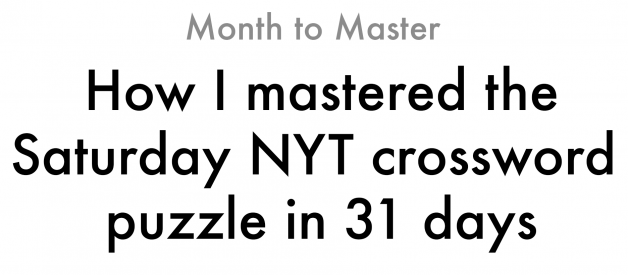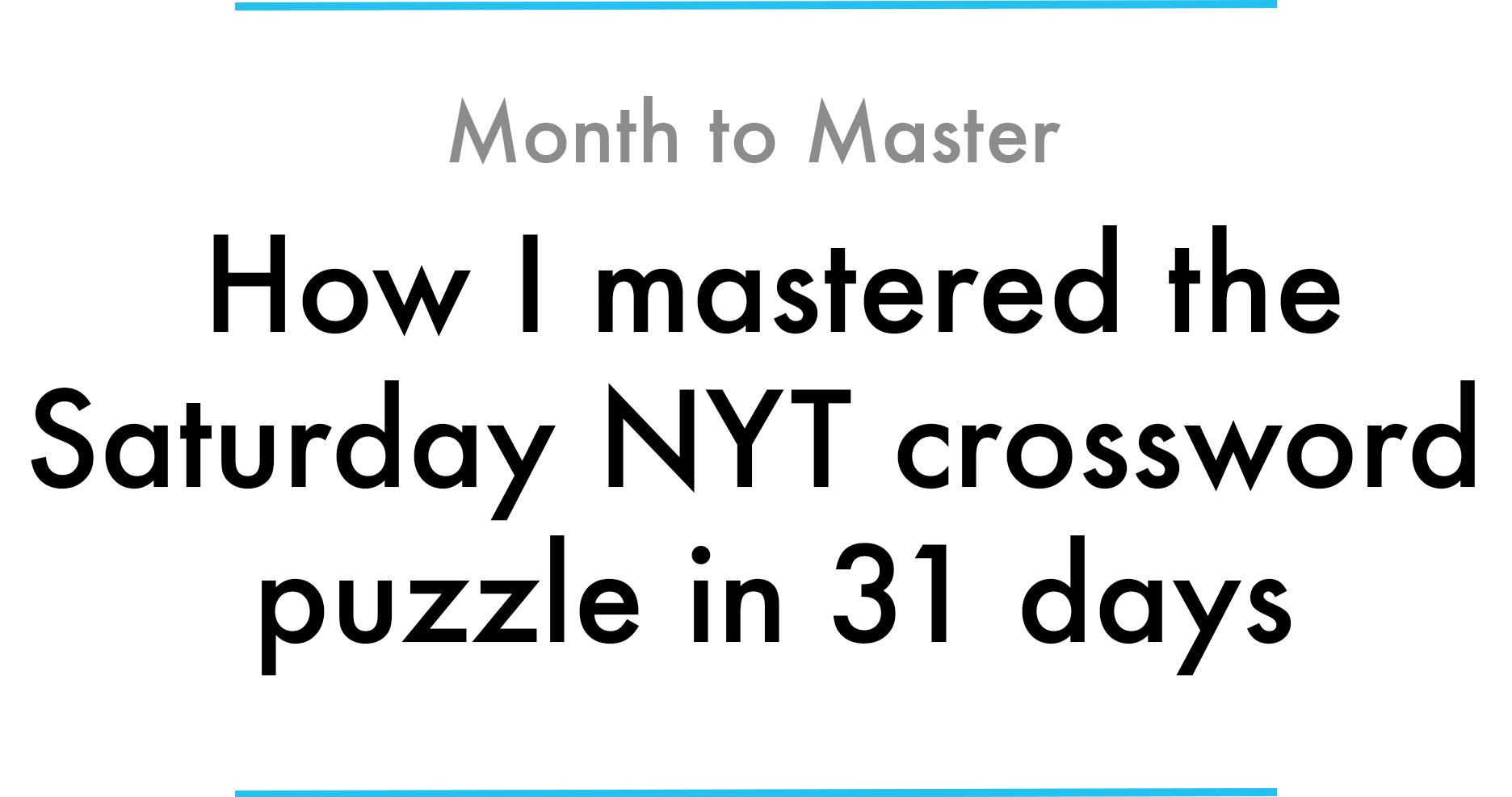
On July 1, 2017, I asked myself the question: With only one month of practice, can I complete a Saturday New York Times crossword puzzle in one sitting without any aid?
On July 23, 2017, after 46 hours of practice, I found out that the answer was yes.
Here?s a link to the full video with commentary.
During the month of July, I documented my entire learning process in a series of 31 daily blog posts, which are compiled here into a single narrative. In this article, you can relive my month of insights, frustrations, learning hacks, and triumphs, as I strive towards monthly mastery.

Today, I start a new month and a new challenge: With only one month of practice, can I complete a Saturday New York Times crossword puzzle in one sitting without any aid.
According to Anders Ericsson, the researcher of expertise whose work is the basis for Malcolm Gladwell?s 10,000 hour rule, crossword puzzles are one of the few things that can?t be mastered in any systematic way.
In Ericsson?s book Peak, he explains that ?some activities, such as playing music in pop music groups, solving crossword puzzles, and folk dancing, have no standard training approaches. Whatever methods there are seem slapdash and produce unpredictable results?.
I?m not sure how folk dancing and crossword puzzles ended up in the same category, but nevertheless, the point is clear: Ericsson, the preeminent authority on expertise and human performance, doesn?t believe crossword puzzles can be mastered in a predictable, accelerated fashion.
So, naturally, I see this as a challenge.
To take this challenge further, I?ve decided to maximize the level of difficulty: The New York Times (NYT) has the reputation for publishing the most challenging crossword puzzles, and the Saturday puzzle is designed to be the most challenging puzzle of the week.
In other words, the Saturday NYT crossword puzzle is the most difficult of all the crosswords. So, if I can crack the Saturday puzzle, I should be able to complete any other crossword puzzle, from the NYT or otherwise.
One point of clarification: The NYT puzzle gets more difficult throughout the week. The easiest puzzle is on Monday and the most challenging puzzle is on Saturday. The Sunday puzzle is a significantly larger puzzle (with a 21×21 grid, versus the Monday-Saturday 15×15 grid), but has a difficulty level of a Wednesday or Thursday.
Defining success
To complete this month?s challenge, I must fulfill three criteria:
- I must complete one entire Saturday NYT crossword puzzle. In other words, the entire 15×15 grid must be filled in ? with the correct letter in every square. If the puzzle happens to be from this month, that would be great, but it?s not a requirement. As long as I?ve never seen the puzzle before, it?s fair game.
- I must complete the puzzle in one sitting. In other words, once I start the puzzle, I must complete it during that session. This is basically a slightly less defined time constraint.
- I can?t use any aids. I can?t lookup any answers or ask for help in any capacity. All my answers must come from my brain.
My starting point
During my freshman year of college, I started doing the NYT crossword every Monday (since the newspaper was freely distributed in the student center and dining halls).
Most Mondays, I couldn?t complete the puzzle (even though Mondays are supposed to be the ?easiest? puzzles of the week), but I came fairly close. I occasionally tried the Tuesday puzzle, but could never get very far.
After freshman year, I mostly stopped solving crosswords, completing only a few easy puzzles every year.
A few months ago, I subscribed to the NYT crossword app, and started solving the Monday puzzles again. I?ve also tried the Tuesday and Wednesday puzzles, but I still can?t solve them without some help.
To set the baseline for this month?s challenge, I tried to solve the Saturday NYT puzzle from today (July 1, 2017).
According to Rex Parker, the most popular NYT crossword blogger, today?s puzzle has a relative difficulty level of easy. In other words, I should expect to do worse on an average Saturday puzzle.
Here?s what I was able to fill in?
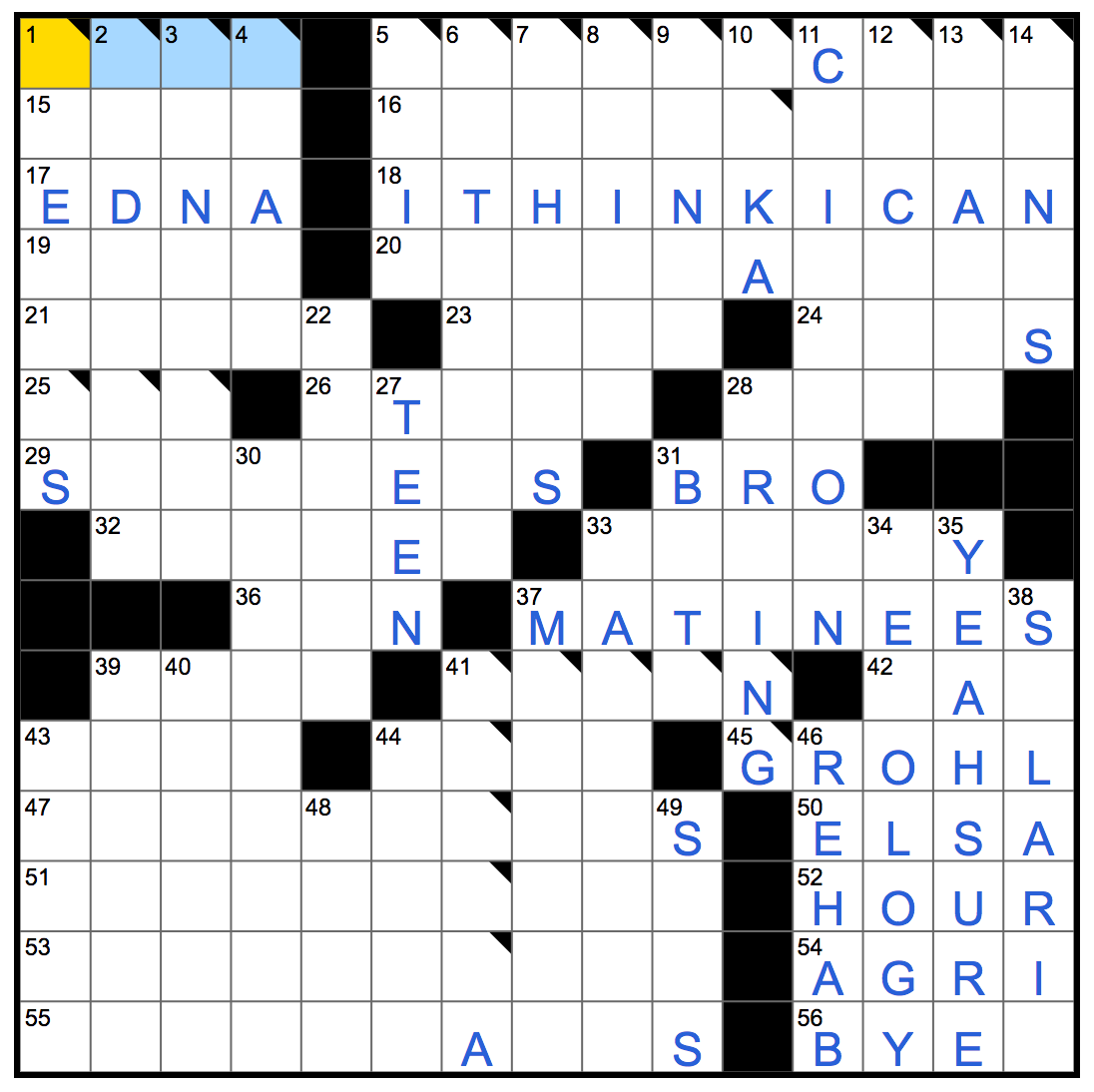
And, if you want, here?s an 18-minute screencast where I commentate as I try to solve the puzzle.
Clearly, I have a long way to go.
As I say in the video, ?I did better than I expected, and worst than I hoped?.
Anyway, I?m excited to see if I can prove Anders Ericsson wrong, but I?m nervous that he might be right. We will soon find out?

Yesterday, I started a new challenge: I?m attempting to solve a Saturday New York Times crossword puzzle in one sitting without any aid.
However, there?s an additional wrinkle to this month?s pursuit?
As I explained yesterday, there is no known systematic method to becoming a predictably better crossword solver. Thus, my secondary challenge this month is to uncover a predictable and accelerated training method that I can actually use.
This may be particularly difficult, since it?s likely that no such training method exists (as I discussed yesterday). If this is the case, I?ll need to resort to a purely brute force method, which is less than ideal.
It will definitely be interesting to see how this story develops throughout the rest of the month.
In the meantime, here are a few ideas that will help me get going:
1. Start by solving a lot of puzzles
My initial plan is to start off by solving (or attempting to solve) a dozen or so Saturday NYT puzzles. In doing so, I will hopefully identify my main inefficiencies, bottlenecks while solving, etc., which I can then remedy through more intelligent, targeted training.
In other words, I?m going to start off with a lightly more mindful version of the brute force method.
2. Study solved puzzles
Given that crossword puzzles can theoretically contain clues and answers from an infinite knowledge base, there?s a lot of obscure information that I?ll need to learn this month.
From past experiences solving (mostly Monday puzzles), I?ve noticed that I slowly absorb crossword knowledge over time, as patterns start to emerge. However, to acquire this knowledge at the appropriate pace, I don?t think I can rely solely on the passive, brute force method. The math just doesn?t work out:
The average Saturday puzzle takes me between 20?30 minutes to ?complete?, which means I?ll only be able to work through ~60 puzzles during the entire month.
There?s no way that I?ll get exposure to the majority of the crossword lexicon solving only 60 random puzzles, so I?ll need to accelerate this process somehow.
One idea is to simply read through already solved puzzles, identify patterns (i.e. clues/answers that occur more frequently), and then memorize/internalize accordingly.
I can likely read through 10 puzzles per hour, which means I can work through 60 puzzles in less than a week, instead of a month.
This honestly still seems like fairly low volume, but it?s a step in the right direction, assuming this method is engaging enough (which I?m not so sure it is).
3. Memorize the most frequently used clues and answers
If reading through solved puzzles still doesn?t give me exposure to a large enough dataset, I?ll need to take an even more extreme approach, where I aggregate all crossword clues and answer from every puzzle ever, sort them by frequency, and then memorize the most popular answers up until some threshold point ? completing removing the context of the puzzles.
I?m not too thrilled about this method either, but it?s an idea.
Clearly, I don?t have much of a plan yet. All three of my ideas are some flavor of the brute force method, which certainly can?t be classified as ?predictable? or ?repeatable?.
Hopefully, once I start solving more puzzles, I?ll find some magical insight that will change everything. But, I?m not holding my breath?

As I explained yesterday, the first part of my training plan isn?t too sophisticated: I?m just going to try to work through as many Saturday crossword puzzles as possible in the next week.
Hopefully, through this high-volume exposure, I?ll begin to identify my inefficiencies, gaps in knowledge, etc., and then be able to use this data to more systematically approach my training.
Ideally, I would work through 52 puzzles this week (i.e. a year?s worth of Saturdays). Of course, I only have about an hour per day, so, in order to hit this 52-puzzle target in this next week, I would need to reduce my puzzle ?solve? time down to around 9 minutes.
Currently, it takes me about 30?35 minutes.
To close this gap, I?ll need to strategically cheat my way through the puzzles. (For the record, I already need to cheat, even to solve the puzzles in 30 minutes, but I will need to especially cheat if I want to cut my solve time by a factor of three.)
Cheating takes two forms: 1. Checking and 2. Revealing.
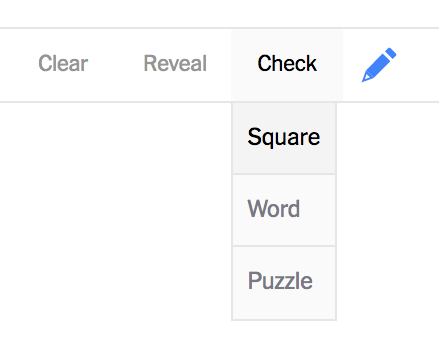
Since I solve on the New York Times website, I?m given the options to ?check? the puzzle, which validates or invalidates the currently filled in squares, or to ?reveal? a particular square, which fills in the correct answer.
By using these cheats, I can maintain my momentum when I get stuck.
The problem is? if I use these cheats too liberally, my brain won?t be engaged enough to learn anything, and if I use these cheats too sparingly, each puzzle will take too long. I need to find the perfect balance.
Today, I experimented with this balance, and was able to cut my solve time to around 20 minutes on average, using a cheat on 27% of the squares (the red triangle means I ?revealed?, and the black triangle means I ?checked? and the previous guess was incorrect).
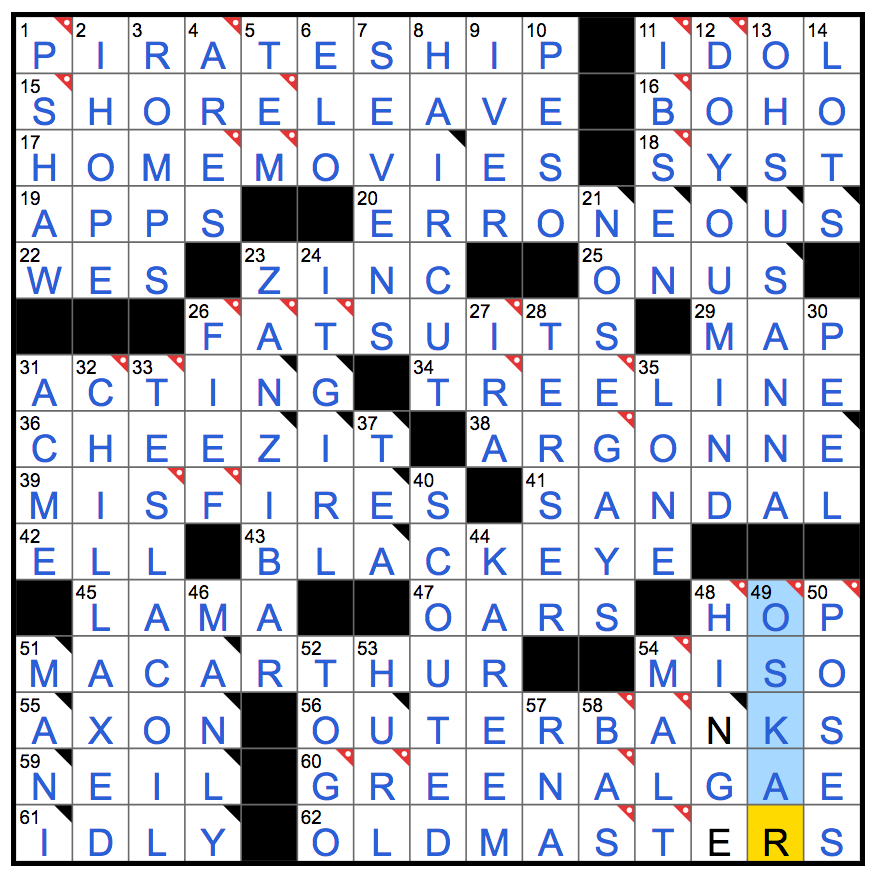
This 10-minute reduction is already a promising start, but I still need to cut a lot more time.
To be honest, I don?t want to cut more time: The fun part about solving a puzzle is the hopeless struggle. Without the struggle, the puzzle loses all of its appeal. The struggle is really the entire point.
But, of course, right now, I?m not trying to optimize for enjoyment (although, it definitely helps as a motivator). Instead, I need to optimize for pattern recognition, which lives in the sweet spot between no struggle and all struggle.
I?m not sure how I know where this sweet spot is. After all, it?s hard to say whether my failure to identify patterns is because of my liberal use of cheats, or because I haven?t seen enough puzzles, or because there just aren?t obviously-learnable patterns. But, I?ll have to do my best.
This is going to be an interesting balancing act.

Yesterday, I declared my training plan for the next week: Work through 52 Saturday NYT crossword puzzles, using ?cheats? (like Check and Reveal) to expedite the process.
Today, to get a head start, I completed ten puzzles, and came to the conclusion that this is a bad plan.
Well, it?s not necessarily a bad plan, but there?s no way for me to know if it?s a good plan.
Basically, as it stands now, my plan requires that I suspend my disbelief, do the same thing for a week, and then, at the end of the week, see if I?ve progressed along some currently unknown axis.
Theoretically, this approach might work out. But it might not. Either way, it?s irresponsible for me to burn through 25% of this month?s training time to find out.
Accelerated learning is all about finding ways to receive fast or immediate feedback, and adjusting the training approach in real-time based on this feedback.
Right now, my feedback loop is a week long, and that?s just not good enough if I want to have any control over the outcome of my training.
I need to find a way to reduce this feedback loop so it?s measured in minutes, not weeks. In this way, I?ll have a much better chance of identifying patterns and productively evolving my training methods over time.
Since I?ve completed a handful of puzzles in the past few days, at least I have a better sense of what kinds of patterns I?m looking for. There are three types:
- Common answers. Which words appear most often in the puzzles? Do I know what they mean? Do I know the ways these words are most commonly clued? Etc. This is the most obvious of the patterns.
- Common clue types. It seems that the New York Times crossword editors control the difficulty of puzzles not based on the obscurity of the answers, but based on the crypticness of the clues. In particular, the editors use a lot of plays on words, double meanings, misdirection, etc. I sense that there are common types of deceptive clues, and I should try to identify and learn these types.
- Best solving practices. Do I find that there are certain solving techniques or approaches that I can use that are consistently more effective? Should I always start with a complete pass through all the clues first, or should I build out the puzzle in stages? Etc. I should try to find a rhythm that works best for me.
To create quick feedback loops for #1 and #2, I?ll likely need to aggregate crossword data and build some kind of training tool (that lives separately from actual puzzles). For #3, I?ll need to continue solving puzzles more or less as I already am.
Tomorrow, I?ll investigate how I might be able to aggregate and analyze crossword data, and then go from there?

Yesterday, I realized that I won?t be able to complete this month?s challenge if I just use the crossword puzzles themselves as my training tools. Instead, I?m going to need to make some sort of training app/program that I can use to receive more immediate feedback and that I can control for more intelligent training.
To build this program, I will need two things: 1. Lots of crossword data, and 2. Some interface that displays this data in some quiz-like form.
Today, I focused on aggregating the data.
Step 1: Find the best data source
After a little bit of googling around, I found a well-suited website called NYTcrossword.com.
Every day, the site?s creator, Bill Ernest, publishes the clues and answers to that day?s NYT crossword puzzle as plain text. Not only that, but he also selects a number of clue-answer pairs, and provides additional useful information (i.e. an explanation of the clue, more info about the answer, etc.).
Here?s what that looks like for today?s puzzle?
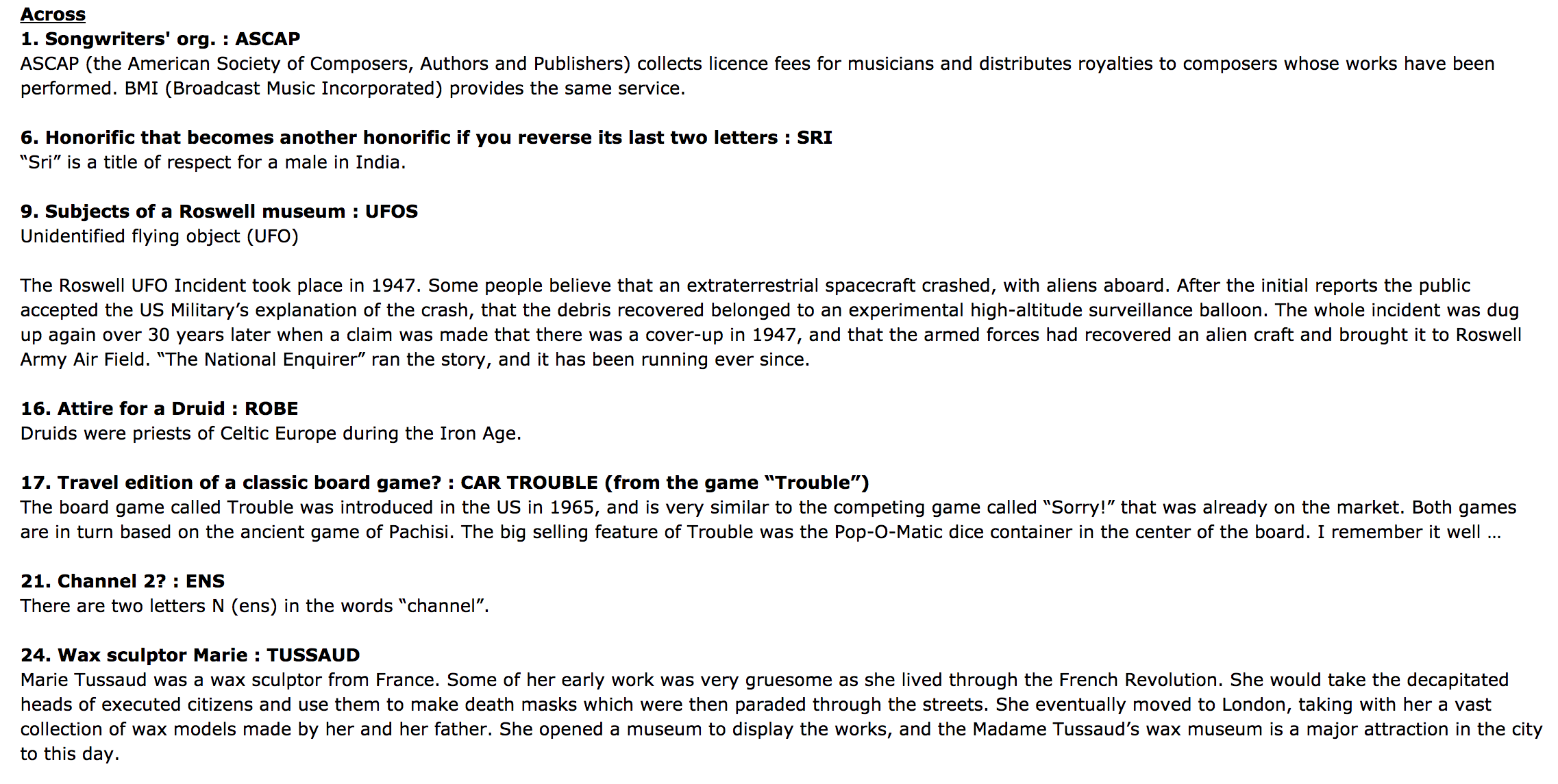
Luckily for me, Bill has been keeping this record every day since 2009.
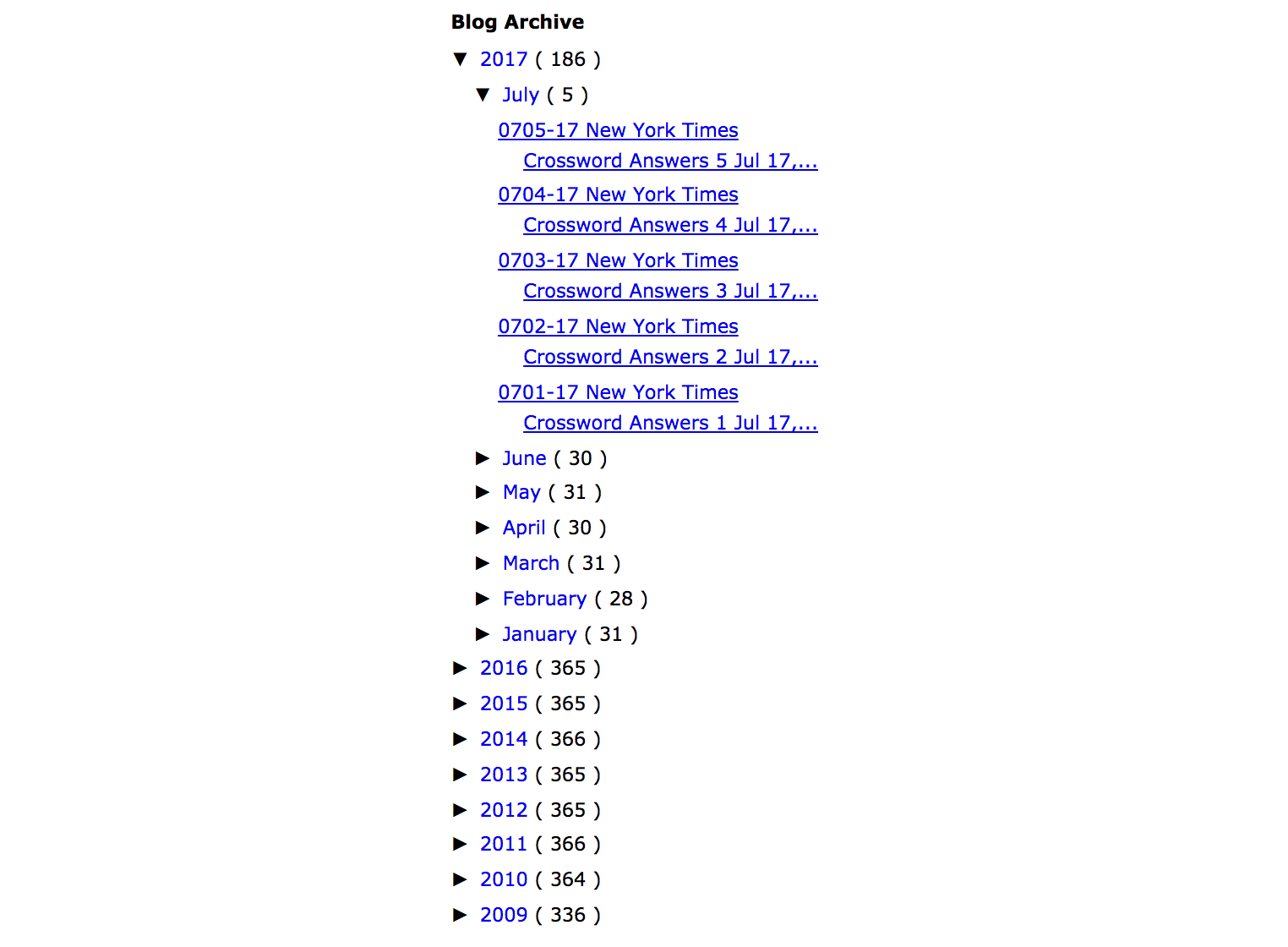
He?s also designed his site so that it?s incredibly searchable/navigable, which makes the next step much easier.
Step 2: Scrape all the data
The next step is to extract all this crossword data from Bill?s site using a technique called web scraping. Basically, to ?scrape? a website, you teach a bot how to navigate the site and which pieces of data to extract as it navigates.
There are a lot of fancy ways to do this, but I?m pretty inexperienced in this area. So, instead, I just relied on the decently-user-friendly Chrome extension called Web Scraper.
Once installed, I was able to access Web Scraper via the inspector (i.e. developer tools) of my browser. It looks something like this?

After setting everything up, I clicked the ?Scrape? button and let the computer do it?s thing.
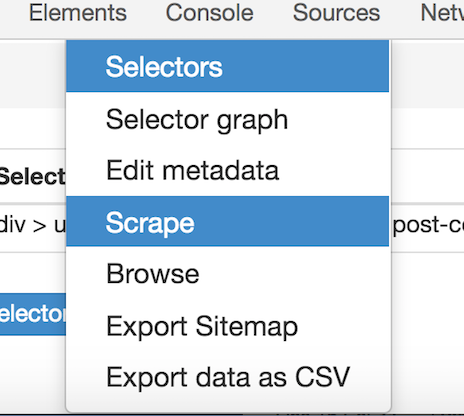
After a few hours, I came back to my computer, Web Scraper had finished scraping, and I exported the data to a CSV.
Important note: I only scraped the data for puzzles published between 2009 and 2016. This means that I can still approach all 2017 puzzles ?cold?, without ever having seen any of the clues previously. Thus, I will use the 2017 puzzles to fairly assess my progress throughout the rest of the month.
Step 3: Clean up the data
With the raw data downloaded, I spent some time cleaning it up until it was in a usable form: Each row includes the year of the puzzle, the day of the week, the clue, the word, the explanation, and the total number of times the word appears in my dataset.
Then, I sorted the list based on frequency? It turns out that ALI is the most common answer across NYT puzzles from 2009?2016, appearing 96 times.
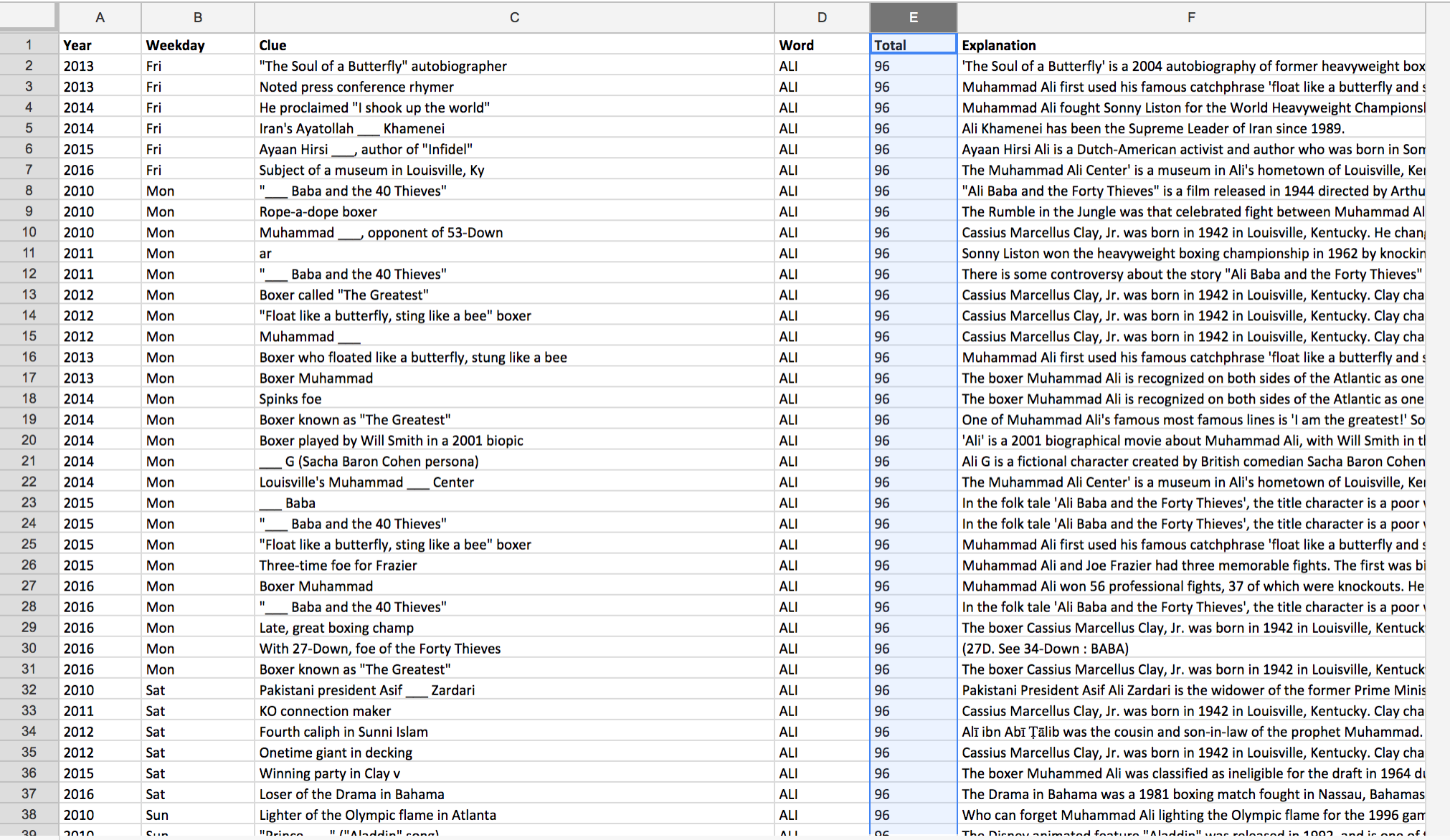
There are 100,336 rows of data, so I?m not exactly sure how I?m going to do anything useful with this, but? I?ll figure that out tomorrow.
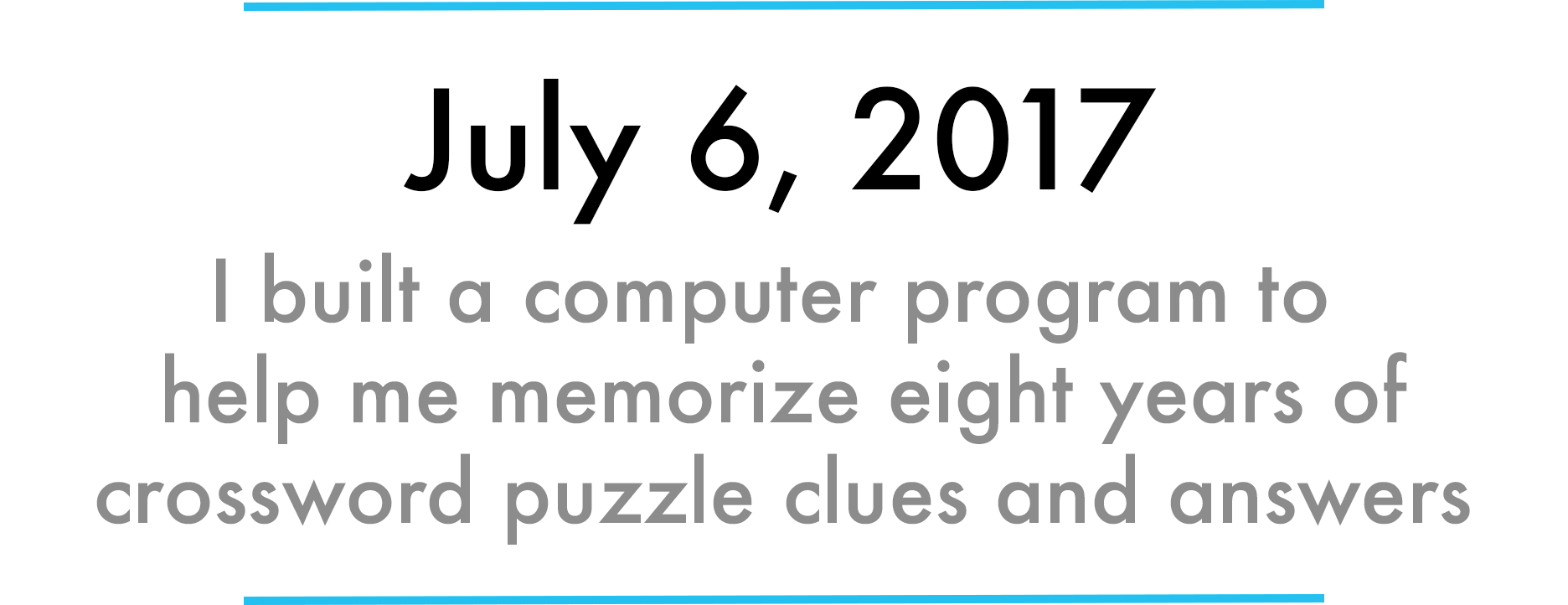
Yesterday, I aggregated 100,000 lines of crossword puzzle data off the internet, which include the clues, answers, and explanations for all NYT puzzles between 2009?2016.
My hope is that I can memorize all 100,000 lines of data in the next ~2 weeks, theoretically improving my crossword solving abilities in a major way.
Then again, this feat would require that I memorize 7,000 lines of data per day, which just doesn?t seem manageable with my current schedule. So, I?m going to have to pick and choose what to memorize and what to leave out.
My choice is straightforward: I?ll remove all the data that corresponds to non-Saturday puzzles, leaving ?only? 12,707 lines of Saturday-specific data.
With this new smaller dataset, I?ll need to memorize 800 lines per day, which still seems like a lot, but is much more doable.
Of course, in it?s current form (as a giant list), this kind of memorization would be sensationally painful and likely not effective. So, to make the memorization a bit more controlled and game-like, I built a ?Crossword Trainer? computer program.
The program is only 17 lines of Python code, and runs in my computer?s Terminal.
import csvfrom random import randintclues = with open(‘crossworddata.csv’,’rb’) as csvfile: reader = csv.reader(csvfile, delimiter=’,’) for row in reader: clues.append(row) length = len(clues)while True: randNumber = randint(1,100) print clues[randNumber][0] print str(len(clues[randNumber][1])) + ‘ letters’ raw_input() print clues[randNumber][1] raw_input() print clues[randNumber][2] raw_input()
Once the program launches, here?s what happens:
- First, the program displays a single, random crossword clue. Underneath the clue, the program displays the number of letters in the answer.
- Then, if I click Enter, the program reveals the answer (to the clue).
- If I click Enter again, the program reveals additional information about the clue-answer pair.
- Finally, with one more Enter, the program displays a new, random clue, starting the process over.
Here?s what it looks like in action:
Today, I trained for an hour using the program, and am feeling quite optimistic about the results so far.
I?ll explain my exact training method tomorrow.
Note: You can download the dataset here.
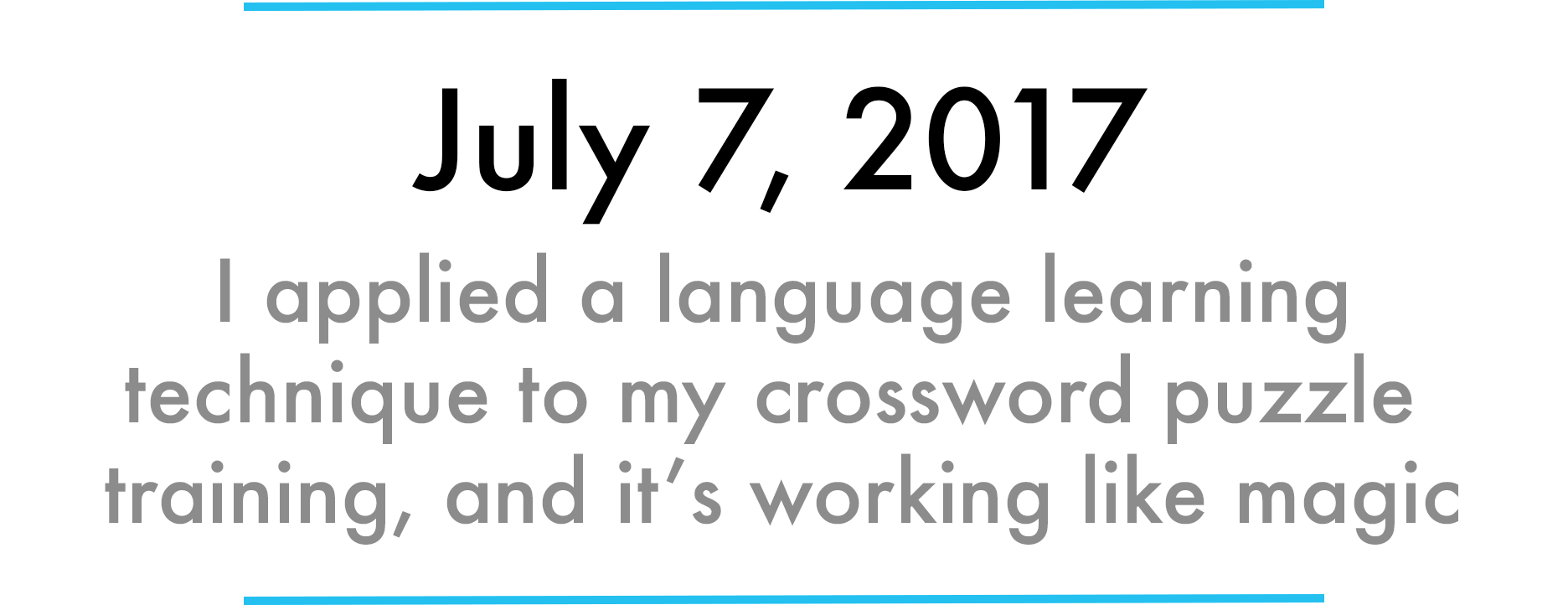
Yesterday, to help me memorize all the clues and answers from eight years of NYT crossword puzzles, I built a ?Crossword Trainer? computer program.
The program displays a random clue . Then, when prompted, it displays the answer and an explanation of the answer.
Also, importantly, I designed the program so I can control the size of the input space. In other words, during a session, rather than having the program randomly select a clue from the entire 12,000-line data set, I can have it select a clue only from 100 lines, for example (where these 100 lines would be considered the input space).
Using this ability to change the size and specificity of the input space of a training session, I was able to craft a highly effective training method. In fact, after two days (four hours) of using this method, I?m shocked at how much I?ve retained: So far, I?ve successfully memorized 1,600 clues and 1,600 answers with essentially 100% retention.
Let me explain how this method works?
The method is based on a concept called Space Repetition, which was originally developed by linguist Paul Pimsleur as an accelerated method for acquiring foreign languages (I also made use of this method during my foreign language challenge in April).
In general, when using this method, new material is first reviewed with high frequency and many repetitions, and then over time, the frequency is reduced and repetitions are spaced further and further apart.
I?ve found this approach easily applicable to the crossword puzzle situation, and a surprisingly pleasant way to train (In fact, I don?t actually have to actively memorize anything? it just sort of happens).
Specifically, here?s how I designed my 54-minute training program (My one-way commute on CalTrain is 54 minutes. Hence, the seemingly random number):
My Crossword Training Program
BLOCK 1: For 6 minutes, use the Crossword Trainer to train on lines 1?100 of the crossword data.
BLOCK 2: For 6 minutes, use the Crossword Trainer to train on lines 101?200 of the crossword data.
INTEGRATION 1: For 6 minutes, use the Crossword Trainer to train on lines 1?200 of the crossword data. (This step integrates B1 and B2)
BLOCK 3: For 6 minutes, use the Crossword Trainer to train on lines 201?300 of the crossword data.
INTEGRATION 2: For 6 minutes, use the Crossword Trainer to train on lines 101?300 of the crossword data. (This step integrates B2 and B3)
INTEGRATION 3: For 6 minutes, use the Crossword Trainer to train on lines 1?300 of the crossword data. (This step integrates B1, B2, and B3)
BLOCK 4: For 6 minutes, use the Crossword Trainer to train on lines 301?400 of the crossword data.
INTEGRATION 4: For 5 minutes, use the Crossword Trainer to train on lines 201?400 of the crossword data. (This step integrates B3 and B4)
INTEGRATION 5: For 4 minutes, use the Crossword Trainer to train on lines 101?400 of the crossword data. (This step integrates B2, B3, and B4)
INTEGRATION 6: For 3 minutes, use the Crossword Trainer to train on lines 1?400 of the crossword data. (This step integrates B1, B2, B3, and B4)
In the past two days, I?ve completed four of these sessions: Two during my two morning commutes and two during my two evening commutes. In total, I?ve learned 1,600 out of the 12,000 lines of data (~13%).
I?ve also spent a few minutes integrating all of the sessions together.
A few things to point out?
- When I add new material, I?m adding the material in blocks of 100. But, this doesn?t mean that I?m adding 100 new crossword answers at a time. Instead, each block contains about 20 distinct answers, each clued (on average) in five different ways.
- As I mentioned, when using the ?Crossword Trainer?, I?m not trying to actively memorize anything in particular. Instead, when I see a clue, I simply try to mentally guess the answer. Then, I reveal the answer (and read the explanation if it?s my first pass through). If I don?t know the answer, I don?t try to remember it. Over time, I?ll naturally start remembering the answers just based on the format of Spaced Repetition.
- I?m already starting to learn a weird array of trivia. There?s a lot of French and Latin words in crossword puzzles apparently. There?s also a fair bit of Greek mythology. Two notably random facts that I?ve learned so far include: i) Noah, from the Bible, had a son named Ham; ii) The original name for Eggo was Froffles.
So far, I?m suspending my disbelief that this knowledge will transfer to new crossword puzzles, but I have a strong suspicion that it will. I?ll look into this further over the next couple days.
In the meantime, I?m going to continue training in this way, as well as continue solving a few puzzles each day.

Today, I continued my normal practice routine: Completing two 54-minute rounds of Spaced Repetition using my ?Crossword Trainer?, and completing two actual puzzles ? one of which was today?s Saturday NYT crossword.
Given that it?s been a week since I worked through my first Saturday NYT crossword puzzle, this seems like a good time to measure my progress.
On Saturday, July 1, I tried to complete the puzzle of the day. I was able to successfully fill in 30% of the squares, which was better than I expected. However, crossword blogger Rex Parker explained that this particular puzzle was the easiest Saturday in a very long time, so my subsequent attempts were noticeably worse (around ~20% completion).
 The July 1, 2017 puzzle
The July 1, 2017 puzzle
Today, after training for a week, I tried to complete the July 8, 2017 Saturday NYT puzzle (which was a more middle of the road puzzle according to Rex Parker), and successfully filled in 47% of the squares ? a nice improvement of ~57%.
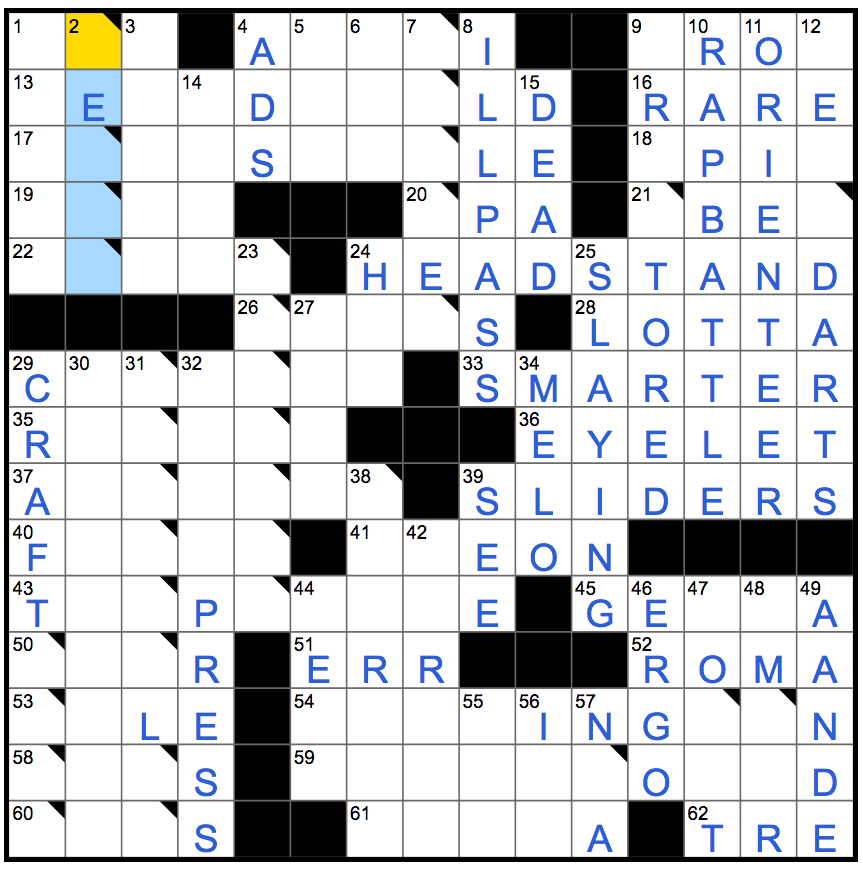 The July 8, 2017 puzzle
The July 8, 2017 puzzle
I then allowed myself to use the ?Checking? functionality on the NYT website, which enabled me to to complete the entire puzzle in a little over 53 minutes.
In 76% of the cases, I filled in the correct letter on my first attempt. For the other squares, I probably averaged around 2.3 guesses per square.
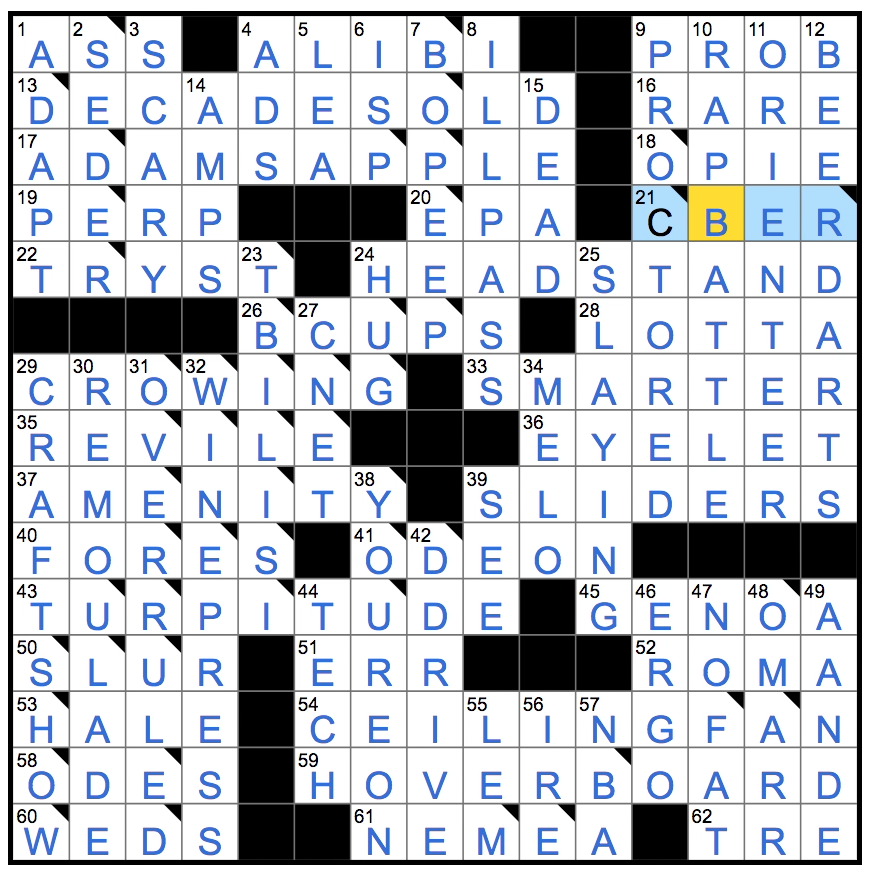
If you?re curious (or have an hour to kill), here?s the 55-minute-long video of me actually trying to solve the puzzle. I commentate again, as the puzzle tortures me.
Overall, I?m moving in the right direction.
I still have a long way to go, but I?m becoming more optimistic: I started the month thinking I had a 5% chance of success. Now, I?m thinking I have a 30% chance.
Still not great odds, but improving?

For the past four days, I?ve been using my ?Crossword Trainer? to memorize previous crossword clues and answers. As of today, I?ve memorized 3,200 out of the 12,707 clue-answer pairs.
This has been a lot of work (eight hours, so far), so I should probably try to quantify what I?m gaining by completing this portion of my training. After all, if I do choose to complete this training, it would require an investment of another 24 hours, which is substantial.
When I first conceptualized the ?Crossword Trainer?, here?s how I hoped things would go:
- I memorize a lot of clues and answers
- Many of these clues and answers are reused in new puzzles
- So, for a given new puzzle, I can easily fill in a large portion of the grid just using memorized answers
- With the memorized answers in place, I should have enough puzzle momentum to complete the rest of the grid without too much difficulty
In other words, I hope that I can solely use memorized answers to surpass the solve threshold of any given puzzle (where the solve threshold is the percentage of completed grid where, if reached, I would be able to fully complete the rest of the puzzle).
I haven?t yet quantified my personal ?solve threshold? (which would also need to take into account puzzle-by-puzzle variance), but, for now, I can probably eyeball it well enough.
Therefore, let?s look at yesterday?s puzzle and see how much of the grid is represented in my ?Crossword Trainer? dataset (i.e. how much of the grid is filled with answers that I have memorized or that I will eventually memorize?).
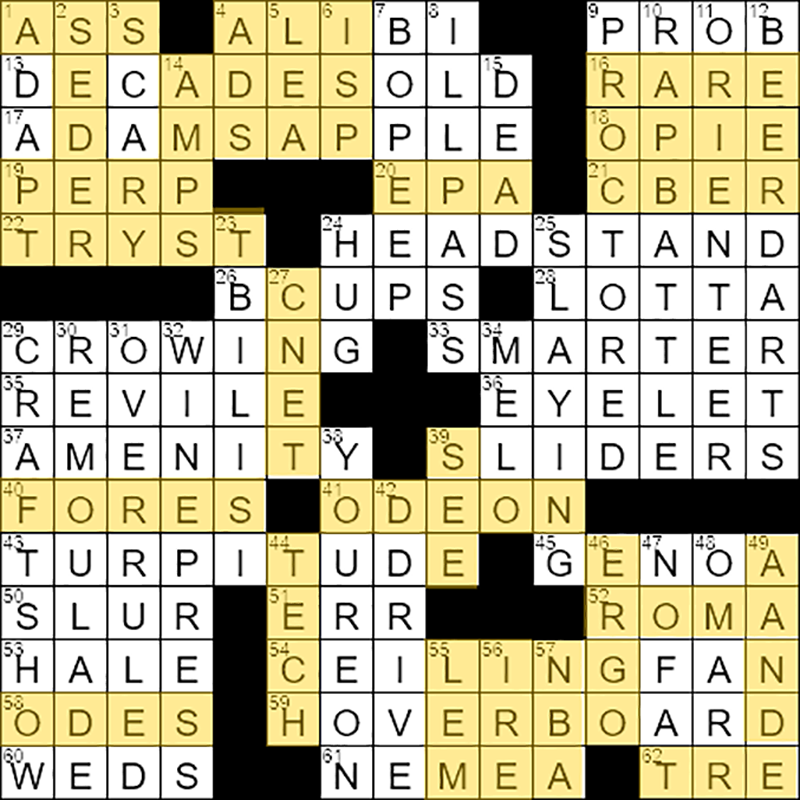
Thus, with perfect recall of every answer from my training set, 45% of the grid (as highlighted above) would theoretically be ?automatic?.
Then, if I layer these ?automatic? answers on top of the answers that I was able to deduce yesterday on my own, the grid would look like this:
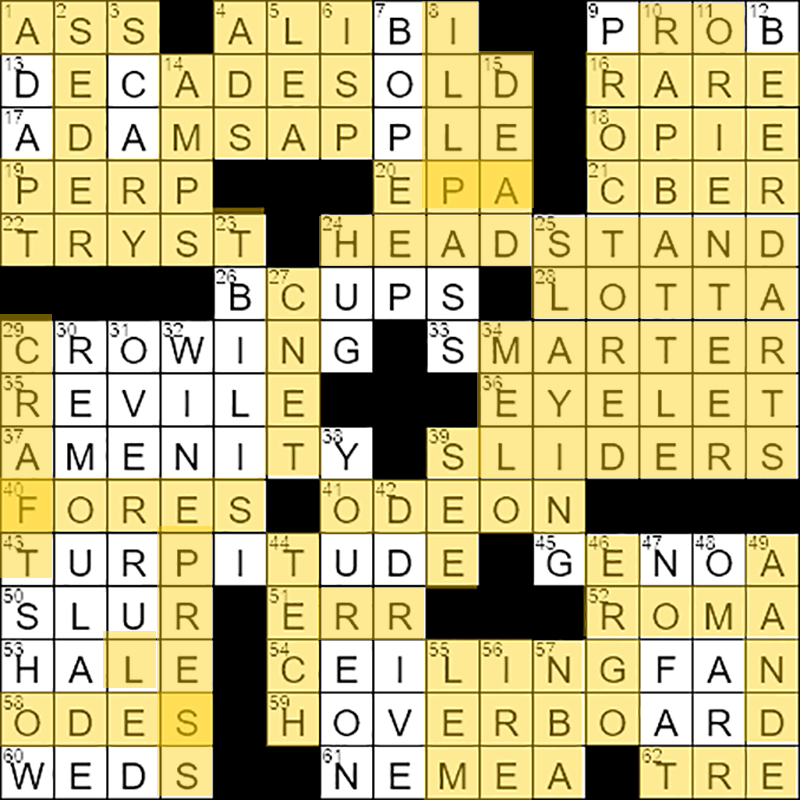
This grid is certainly past the solve threshold, and would be fully solvable.
In other words, it seems that if I finish memorizing all 12,707 clue-answer pairs, I should be able to successfully solve a Saturday NYT crossword puzzle with reasonable ease.
Right?
Not quite. Unfortunately, the analysis I use above is flawed in one very major way: Just because a memorized answer is in the puzzle doesn?t mean that the memorized clue relates to the new clue in any recognizable way.
In other words, the same answer with very different clues is far from being an ?automatic? fill-in.
For example, take the answer to 62-Across, TRE.
From my dataset, I?ve memorized the corresponding clue ?30% of dieci?. But, what if, instead, TRE was clued like this: ?Amount over due??.
These are both reasonable clues (dieci is Italian for ten, due is Italian for two, and tre is Italian for three), and yet, there?s no way that my knowledge of one translates to the other in an ?automatic? kind of way.
If my brain wasn?t primed for Italian, I?m not sure I would catch the ?due? misdirection.
And, of course, this is a benign example. These clues happen to be fairly related. Some answers can be clued in extremely different ways.
So, I should redo my analysis of yesterday?s puzzle, where I only highlight the answers that both 1. appear in my dataset and 2. have clues in my dataset that are directionally related to the clues from the actual puzzle.
If I do that, here?s what the grid looks like?
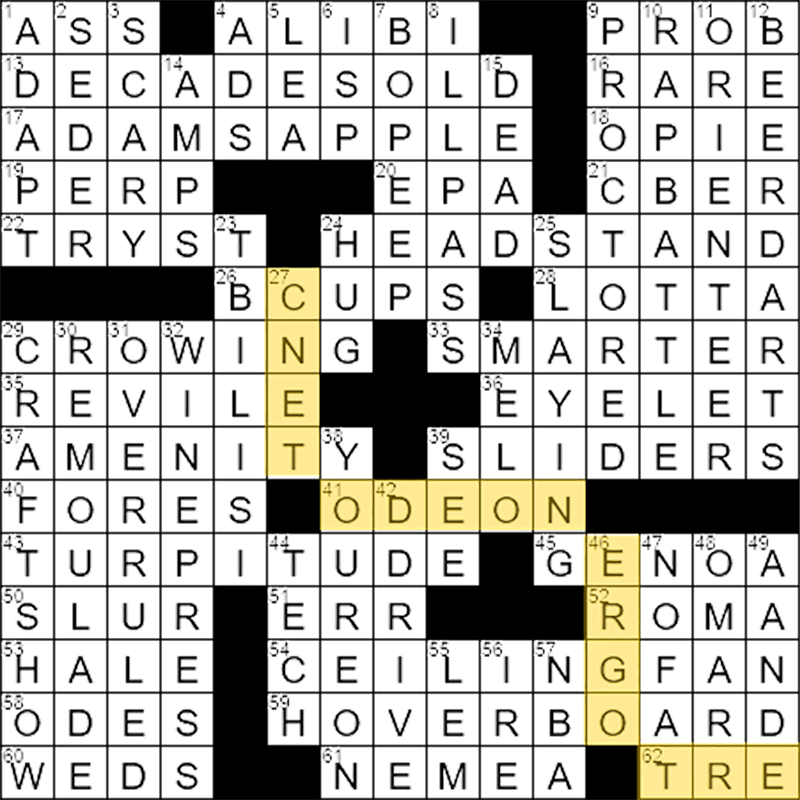
Only four answers would have been automatic or nearly automatic. Every other answer was clued in a completely different, unrecognizable manner.
This is much less promising, and clearly very far from the elusive puzzle threshold.
Thus, it begs the question? Should I even continue training with the ?Crossword Trainer??
Despite this less-than-optimal analysis, I still think that I should continue ? at least for another week.
Even if I?m not getting automatic fill-ins, I do seem to be gaining other useful, but not-yet-quantified skills: 1. I?m learning to better recognize common types of misdirection; 2. I?m building some sort of statistical mental model of which letters are most likely to sit next to which other letters (sometimes as a function of the clue, if it?s a foreign word, etc.); 3. I?m learning what the most commonly used answers are, which I still might be able to recognize in the grid, even if the clue doesn?t match the clue I?ve learned; etc.
For the next few days, I?ll proceed with this training method, but I?ll need to figure out a better way to quantify my progress moving forward.

Today was a weird day for my brain.
When my alarm went off this morning, I was already awake. Or, at least, mostly awake. My head was on my pillow and my eyes were closed, but my brain was definitely already on.
Some unknown amount of time early, in the middle of the night, I woke up to use the bathroom. On my walk to the bathroom, my brain decided it would be well-timed to come up with an exciting idea (about a project I?m working on). This excitement was joined with a wave of adrenaline.
For the rest of the night, I attempted and failed to get back into a deep sleep. As a result, my brain was less sharp today than normal, which became a problem quickly?
In the past few days, I?ve been able to fully solve Saturday puzzles if I allow myself to use checking but not revealing. Today, I couldn?t even come close to finishing a Saturday puzzle ? even gradually revealing the answers didn?t really help me build momentum.
It seems a tired brain is just not-well-suited for wordplay, puns, and aggressive misdirection.
Of course, I knew this, but I didn?t realize quite how intense the difference would be between 100% brain and whatever my brain was at today.
At lunch time, I gave a Saturday puzzle another try, but my brain still wasn?t working and I decided it was best not to push too hard.
I still wanted to practice in some way though, so I figured that a Monday puzzle (the easiest puzzle of the week) might be a good way to relax while also keeping my momentum moving forward.
Since I?ve only been solving Saturday puzzles as part of my training, I was interested to see how I would do on a Monday. At the beginning of the month, I was able to struggle my through most of a Monday puzzle, and could usually finish it if I cheated a bit.
I opened today?s Monday puzzle and went to work. Despite my tiredness, less than eight minutes later, the puzzle was completely and perfectly done (well, actually I made two typos in my haste, but I had known and thought I had properly filled in the answers)?
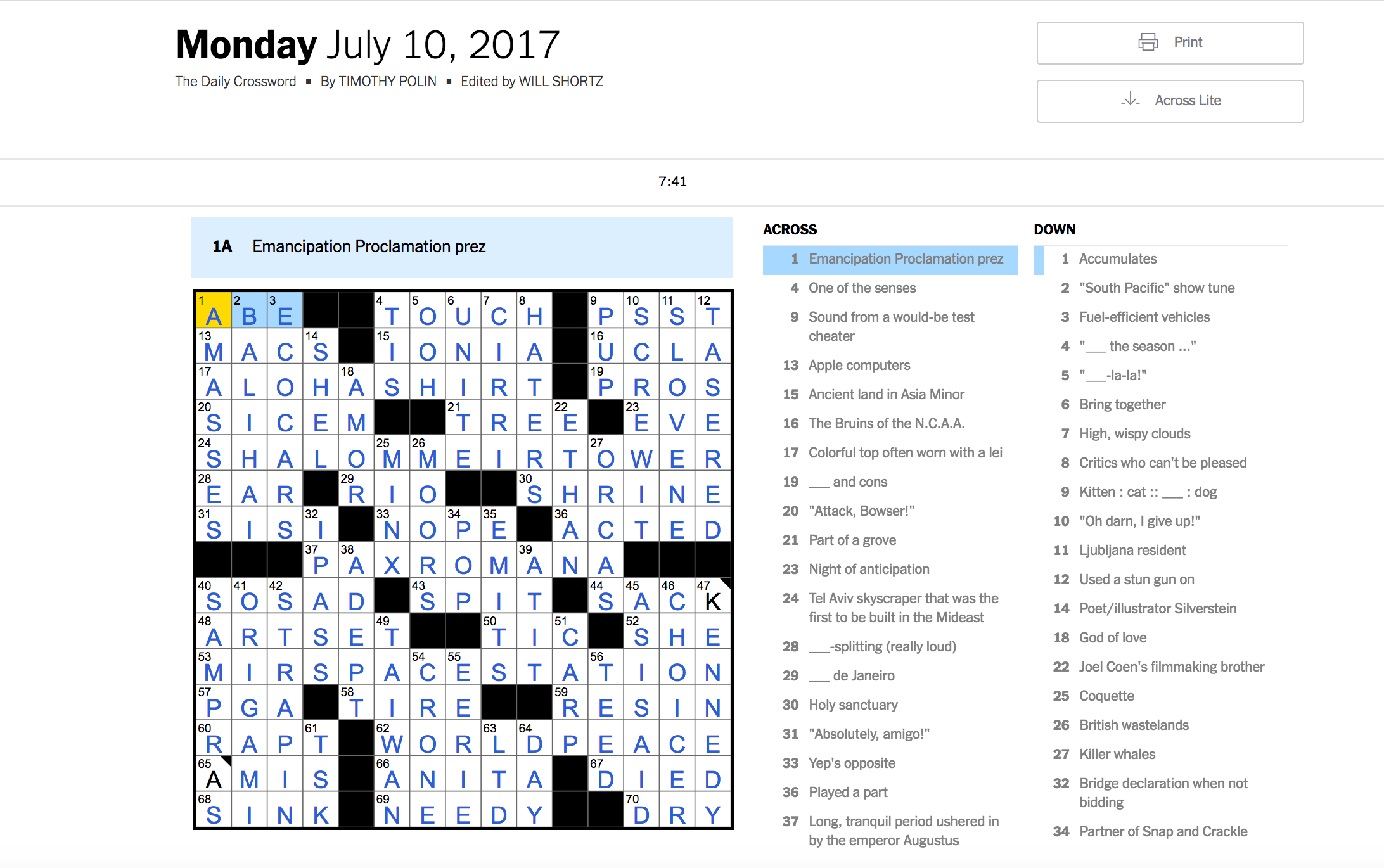
Not only was the puzzle quick and easy, but it was almost laughable how straightforward and literal the clues were. It was like I had taken the weights off of my bat, and was now swinging my way through the crossword with ease. It felt like a completely different puzzle.
It?s been one week and it seems I?ve already completely recalibrated the way my brain perceives the level of crossword difficulty (which I?m quite excited about).
Perhaps, there?s some way I can create the weighted bat version of a Saturday puzzle, allowing me to shift my baseline past what I?ll eventually need for a normal Saturday. I?m not exactly sure how I?ll do this, given that the NYT Saturday is supposed to be the ?hardest puzzle around?, but it?s something to look into.
Anyway, this surprise on the Monday puzzle was a nice way to offset my disappointment from my Saturday puzzle regression. Hopefully, I?ll get a good night sleep tonight and my brain will have a more normal day tomorrow.

So far this month, my training has been almost exclusively focused on two things: 1. Memorizing the most popular crossword answers and 2. Learning how to identify and interpret the main types of cluing misdirection.
One thing I haven?t put too much time into is solving technique.
In other words, what?s the best way to actually approach a NYT crossword puzzle? Or, more specifically, based on my current knowledge of clues and answers, can I improve my puzzle-solving abilities through some sort of solving-focused optimization?
In reviewing my practice logs (and some screencasts of my solves), I noticed an interesting pattern in my approach to the puzzles:
- First, I usually work through all the Across clues and all the Down clues, in order, filling in all the words that I know right away.
- I then find the most densely filled-in part of the grid, and work my way through that area until I get stuck.
- I proceed to move around the rest of the puzzle in this way until I can?t solve anything more.
- Then, I use the ?Check? option to reveal how much of the puzzle so far is correctly filled-in. Typically, I?ve made a few mistakes, and I erase those.
- Somehow, after erasing the incorrect letters, I?m able to make more significant progress, using the newly-created empty space as cues to reassess the corresponding clues and assumptions that I made.
- Eventually, I can?t solve any more of the puzzle and will ?Check? again, erasing everything that I?ve gotten wrong. And so on.
In my mind, before going through this exercise, I imagined that I was mostly using the ?Check? functionality as a way to validate my not-so-confident guesses. But, in reality, I?m using the functionality as a way to invalidate my guesses.
This might seem like the same thing, but the distinction is important: My ability to move forward is often more predicated on knowing when something is not the right answer.
So, here?s my idea: When I get to the point in a puzzle where I?m completely stuck, I should just assume that I?ve made some mistake somewhere. Then, I should search through the puzzle, find the answer I?m least confident about, assume that it?s completely wrong, and erase it. Then, hopefully, this manufactured anti-knowledge helps me make forward progress. If not, I should then remove the next least confident answer, and so on, until I start building forward momentum again.
This might sound like a horrible idea, where I end up erasing the entire puzzle, but, despite it?s counterintuitive nature, it seems to be working.
Today, I put this idea into practice, while solving a Friday puzzle from 2017. Fridays are almost as challenging as Saturdays, and since the puzzle is from 2017, none of the clues and answers are in my training set ? so, this is a genuine solve. (I?m saving the 2017 Saturdays for later in the month).
In 20 minutes, I was able to almost completely finish the puzzle, with only a few blemishes in the northwest corner.
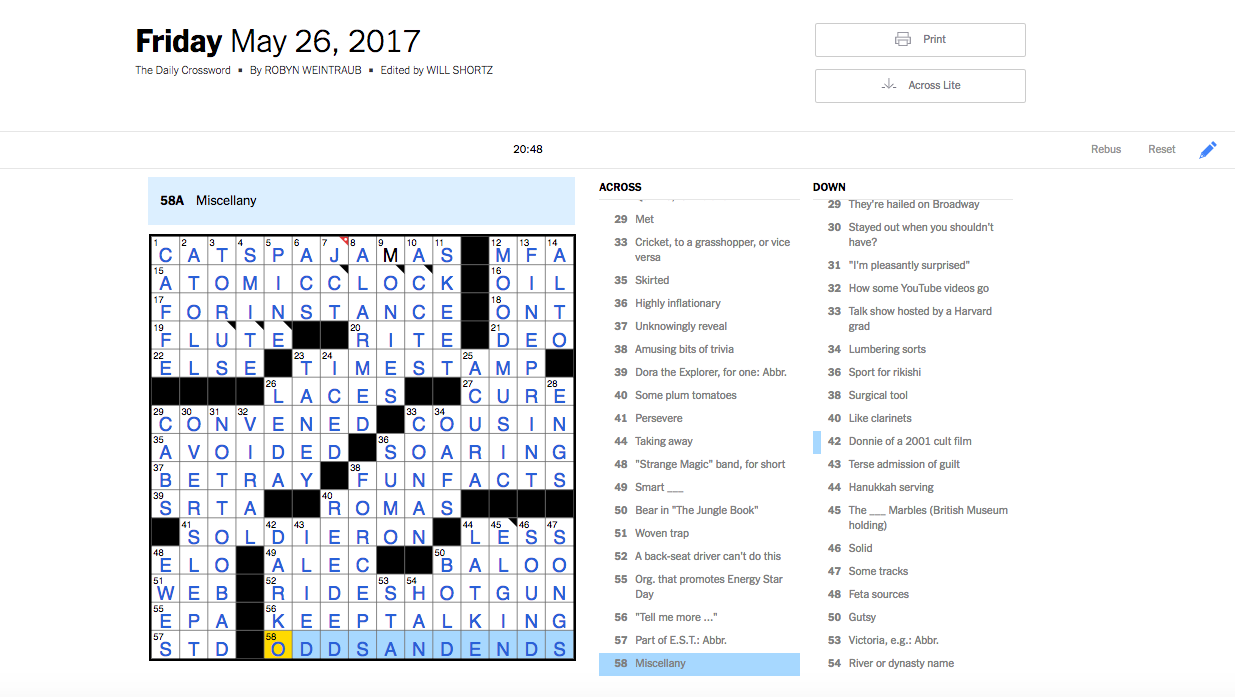
I wasn?t sure if this was just an extra easy puzzle, so I headed over to Rex Parker?s crossword blog to see his opinion. He thought this was a ?Medium-Challenging? Friday puzzle (which likely equates to an ?Easy-Medium? Saturday puzzle), so I was pretty happy about that.
Still, it will be interesting to see if this was just a fluke, or somehow this delete everything until I can make forward progress approach is actually an effective method.
Despite it working, it still feels like a bad idea.
I?ll try it again tomorrow and find out.

Almost one week ago, I built my Crossword Trainer, a computer program that helps me memorize past crossword clues and answers. After only briefly using the program and seeing encouraging results, I realized that the Crossword Trainer would play a major role in my practice regiment during this month.
With this enthusiasm, I spent the next few days intensely learning over 4,000 pairs of crossword clues and answers. As I learned more words, my crossword solving abilities noticeably improved. Everything was going great.
Then, three days ago, I attempted to quantify the exact benefits of memorizing all these words via the Crossword Trainer. The results were less encouraging than I hoped: Basically, most answers in any given new crossword puzzle wouldn?t be represented in my training set, so the Crossword Trainer was really only helping me get a general feel for clues and answer, and nothing more.
Still, getting this general feel is an important step, but it?s harder to quantify when I?ve reached a level of general feel where extra effort only offers diminishing marginal returns.
In the past few days, I?ve tried using my trainer during my commute, but consistently felt like I was wasting my time (i.e. that my general feel wasn?t improving in any noticeable way), and thus, I opted to just solve normal puzzles instead.
Interestingly, in the past few days, since I?ve stopped using the trainer, the variance in my solves has gone way up. On some puzzles, my performance is encouraging. On others, I can barely make a dent in the grid. My consistency has regressed in some fashion.
Also, today, I came across a few clues where I knew I had studied the answers previously during a Crossword Trainer session, but couldn?t actually remember what I had supposedly ?memorized?. This was particular disheartening.
Clearly, the Crossword Trainer is important, even if I?m still not fully able to quantify or measure it?s benefits.
Tomorrow, I need to return to the Crossword Trainer with the seriousness that I had when I first started using it.
It?s time for me to stop slacking off?

For the past few days, I haven?t been practicing in the most deliberate or focused manner, which I was finally able to admit in yesterday?s post.
This slump in performance wasn?t due to less energy or less willpower or less discipline. Instead, I simply lost my motivation to practice in this way.
With that said, I didn?t lose my motivation for the project as a whole ? in fact, I?ve been feverishly solving crosswords every day ? but, I did lose motivation for the most structured and important part of my training: The Crossword Trainer.
This loss of motivation came from a loss of belief: I no longer believed that the Crossword Trainer was actually helping me.
As a result, I couldn?t justify to myself in any way that it was worth investing in this training method any further.
However, after a few days of barely using the Trainer, I realized that this was a faulty belief. By way of counterexample / negative space, I was able to once again appreciate the power of and need for this training method, thus rediscovering my motivation.
Today, with this renewed motivation, I was able to spend 90 fully-focused minutes with the Crossword Trainer. Tomorrow, I will do the same.
A more general note: In my eyes, this notion of belief as the driving force of motivation is the foundation of all learning.
Often, we don?t believe that we are the kind people that are good at math, or are good at learning foreign languages, or are artistic/creative/musical, or whatever it might be. As a result, without this belief, we lack the motivation or internal justification to pursue these kinds of endeavors.
But, here are the two important things to remember?
- In all the research on expertise, there is no evidence that there are kinds of people who are naturally gifted with aptitudes for particular areas. Instead, we are all just people who each have the aptitude to essentially become good at whatever we want.
- Beliefs are just stories we tell ourselves in our brains. The good news about internal stories is that we can rewrite these stories if we chose to.
In other words, as you consider learning something new or while you are in the process of learning something new, it?s important to observe the stories you tell yourself and the beliefs you hold. Recognizing when these beliefs are unfounded is an important step towards more effective learning.
While the belief I?ve held over the past few days originated from a seemingly more analytical place, it was still holding me back. Luckily, I have a tendency to constantly monitor my beliefs, so I was able to reassess and adjust accordingly.

It?s been two weeks since I started this month?s challenge, and so far, my approach has a been a bit all over the place.
This was to be expected, given that I started the month with no clear training plan. However, without a clear framework, I?m finding it more challenging to build a coherent multi-day practice plan, as well as tedious to construct my daily posts (since each post doesn?t have the luxury of sitting within a well-defined narrative structure).
Today, I?m finally starting to build a better mental model of Crossword Puzzle Training, which I share here?
My two-step approach to mastering Saturday NYT crossword puzzles
1. THE DATA ? Build a giant mental corpus of crossword clues and answers, using programatic Spaced Repetition
Crossword puzzles are basically a test in vocabulary, general knowledge, wordplay, and letter-proximity statistics. In general, because of the standardized crossword construction rules and the fact that all crosswords are edited by the same person (Will Shortz), there are significant learnable patterns in the vocab and wordplay across Saturday NYT puzzles.
Thus, the greater my knowledge of the most common crossword vocabulary and types of wordplay, the better prepared I am to make a dent in a Saturday puzzle.
I?ve largely figured out how to train for this part of my approach, as I?ve described in my past posts about the programatic Crossword Trainer.
Importantly, this ?data? step must be completed sequentially first: Without a reasonable grasp of possible clues and answers, it doesn?t matter how effective my other weapons are ? without the data, I won?t have the necessary ammunition.
2. THE MINDSET ? Train my brain to remain open and resilient, allowing me to build ?grid momentum? towards the Solve Threshold
Assuming that I?ve acquired the necessary amount of data ammunition, the primary remaining limiting factor is completely mental?
I?ve noticed that when I solve a puzzle, if I am able to successfully fill in the first few answers, I build confidence and momentum that carry me through the rest of the puzzle (up until I reach the critical solve threshold).
However, if I struggle on the first handful of answers, I lose confidence and my brain shutdowns, losing its ability to effectively parse the clues.
In other words, I basically already have all the data I need to solve a Saturday puzzle (which I?ve demonstrated on the easily-started puzzles), but I?m sometimes not coming to the other, less-easily-started puzzle with the same necessary mindset (even if these puzzles, on the whole, are equally as difficult).
So, the second piece to my crossword training approach requires that I train my brain and mindset. In particular, I want to ensure that 1. I don?t prematurely pass judgments about my abilities (based on early feedback from the puzzle), and 2. I bring an optimally focused, creative mindset to each puzzle, ensuring that I?m operating at my maximum level of clue cracking.
This might sound a bit pseudo-scientific and non-trainable, but, in fact, this is exactly analogous to my entire journey learning how to backflip.
On Day 3 of my backflip challenge, I proved to myself I had the raw strength and coordination to land a backflip, but my brain still refused to comply. Thus, the rest of the month was focused on systematically training the fear out of my brain.
I will need to train my brain?s crossword abilities in a very analogous way.
I have some ideas about how I?ll do this, which I?ll share in upcoming posts.

It?s Saturday again, so it?s time to formally check in on my progress since last week ? using today?s Saturday NYT puzzle as the barometer.
Today, I was able to fill in 140 out of the 195 squares of the puzzle, or 72% of the grid, without any aid. This is certainly a better-than-expected week-over-week improvement.
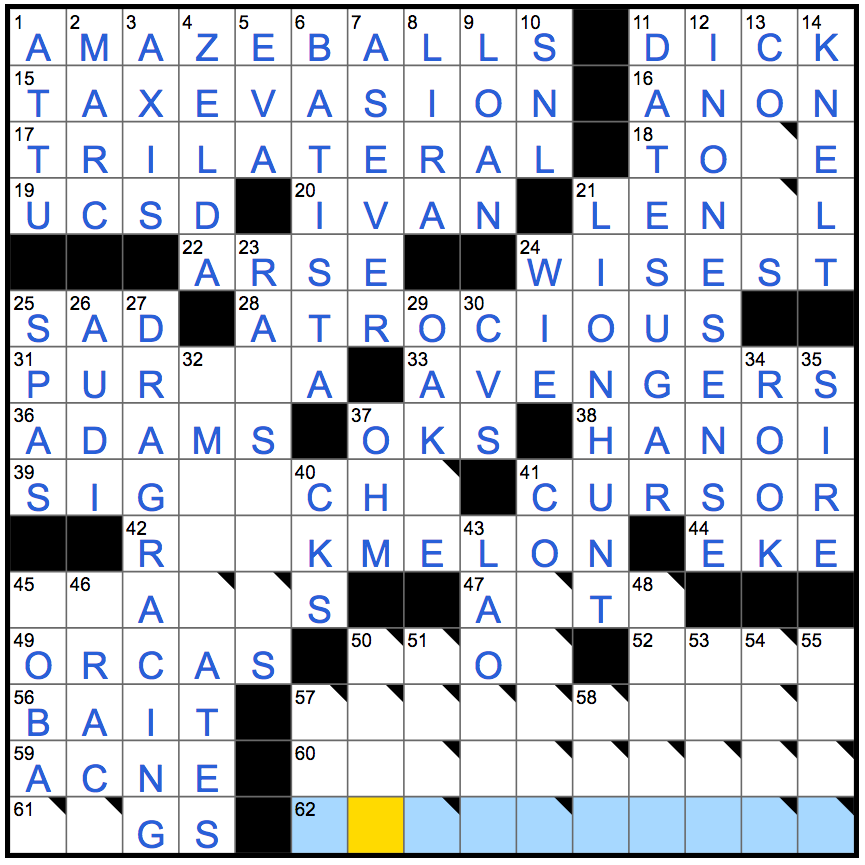
While I didn?t actually feel like I got better this week (in fact, my confidence noticeably dipped), now that I?ve compared today?s performance to my performances on July 1 and July 8, my progress is undeniable.
On July 1, I completed 30% of the puzzle (on the left). On July 8, I completed 47% of the puzzle (in the center). And now, on July 15, I completed 72% of the puzzle (on the right).

Interestingly, according to Rex Parker, today?s puzzle was also the most difficult puzzle of the three (relative to the average Saturday puzzle).
Here?s a timelapse of today?s effort?
It seems that the constant feeling of struggle this week wasn?t actually a bad sign, but instead, an indicator that I was pushing myself to improve.
Still, going into this puzzle, my brain was low on confidence and a bit shut down. It took me a good few minutes to find my rhythm, but once I did, I built some solid momentum.
If you watch the entire hour-long video, with commentary, you?ll see me struggle for the first few minutes, and then, all of a sudden, something clicks in my brain and I start performing at the upper boundary of my training.
Today?s solve was a major confidence boost, and I?m looking to ride this high for as long as I can.
More likely though, I will need to continue aggressively training, forcing myself to once again confront the limits of my own intelligence, which is always fun.
But, this kind of training is how effective learning happens, so I?m prepared for the temporary (sometimes, oddly pleasurable) pain that?s yet to come.

Yesterday, I solved the Saturday, July 16 NYT crossword puzzle on video, successfully solving 72% of the grid without any aid. This was my best performance yet.
Reviewing the video, it?s fascinating to see how my momentum shifts throughout the solve. During parts of the solve, I find significant momentum and many answers fall quickly into place. At other points in the solve, I reach a near standstill.
In the past week, these standstills have been my biggest mental vulnerability: It?s easy to give up on the puzzle in these moments.
Therefore, it?s important that I specifically focus my training on overcoming these points of low momentum, and maintaining the necessary mindset.
These low-momentum moments happen at two main points during the solve: 1. At the very beginning, and 2. Towards the middle, once I?ve juiced the puzzle for as many squares as I think I can.
In the past week, I was having noticeable trouble getting past #1. However, after my confidence boost from yesterday?s solve, this doesn?t seem like it?s as big of an issue anymore (at least during today?s solves).
So, over the next few days, I?ll focus my training on #2: How do I push forward once I?m at the point where it feels like I have no more leads into the empty parts of the grid?
In the video, because it was on video, I had the extra motivation to push myself a bit harder than normal, which forced me to improvise and find a decent solution to this problem?
Basically, once I got ?stuck?, I started making a series of low-probability guesses, almost exclusively based on letter statistics and nothing else (i.e. ?Based on the surrounding filled-in squares, what letter is most likely to be in this empty square??).
After filling in a handful of squares in this fashion, my brain was then challenged to justify these guesses against the corresponding clues. Occasionally, I would see something that actually made sense, unlocking a few more letters.
Then, I would erase the dead-end guesses, try to proceed with the puzzle, and, once I got stuck again, revert back to more letter-based guesses.
This Expanding & Contracting approach seems to be the best way to overcome a loss in momentum. In fact, in many cases, all I?ve needed was one more letter to unlock sizable areas of the puzzle.
Thus, it seems important that I train my letter statistics abilities in a more deliberate fashion (so I can optimally apply this Expanding & Contracting approach).
Perhaps, I can build another computer program?

Yesterday, I described the Expanding & Contracting (E&C) method for pushing a ?stuck? crossword puzzle forward. The technique uses low-probability guesses, specifically related to letter frequencies and statistics.
For example, if I know a particular six-letter answer is I _ O N I _ , would I be able to guess, just based on word shape and my knowledge of the English language, that the last letter is most likely a C, giving me I _ O N I C, and then subsequently guess that the second letter is also a C, giving me ICONIC?
This ability to build out answers, not based on clues, but based on likely letter patterns is an ability I want to cultivate further (as it?s foundational to the E&C technique and how I plan to level up my crossword-solving abilities).
By nature of solving puzzles for the last two weeks, I?ve already started developing a reasonable mental representation of common letter patterns, but I haven?t trained this ability in any deliberate or focused fashion.
Thus, to do so, I built a new computer program called the ?Letter Trainer?.
Here?s how it works?
- First, an answer is displayed to me with one letter replaced by a question mark (i.e. I?ONIC).
- In my head, I try to guess what the letter is.
- If I click the Enter key, the clue which corresponds to the answer is shown (i.e. ?Quintessential?)
- In my head, based on this clue, I update my guess. Sometimes, if the clue is suggestive of a foreign language, a name, etc., my guess will change to incorporate this new information.
- If I click the Enter key again, the answer is shown in it?s entirety (i.e. ICONIC).
- In my head, I make a note of whether or not I answered correctly, subconsciously tweaking my mental model of letter patterns.
- If I click the Enter key again, an explanation of the answer is shown (just in case I don?t know what the answer means, and want to learn about it).
- If I click the Enter key one last time, the process starts over with a new answer.
The program is simple, only 25 lines of code, but gets the job done?
import csvfrom random import randintclues = with open(‘crossworddata.csv’,’rb’) as csvfile: reader = csv.reader(csvfile, delimiter=’,’) for row in reader: clues.append(row) length = len(clues)while True: randNumber = randint(0,length) randWord = clues[randNumber][1] randAnswer = randWord.replace(” “, “”).replace(“-“, “”).replace(“‘”, “”).replace(“!”, “”) lenRandAnswer = len(randAnswer) randLetter = randint(0,lenRandAnswer-1) answerList = list(randAnswer) answerList[randLetter]=’?’ output = “”.join(answerList)print output raw_input() print clues[randNumber][0] raw_input() print clues[randNumber][1] raw_input() print clues[randNumber][2] raw_input()
To use the program, I can run it in Terminal, which looks like this?
I?ve considered a few other variations of this program (multiple question marks per answer, two answers intersecting at a question mark, etc.), but this most simplified version seems to be sufficient for now.
Tomorrow, during my commute, rather than training with the Crossword Trainer, I will train with this newly-created Letter Trainer and see how it goes.
I?m optimistic that it will help.

Yesterday, I built the Letter Trainer, which is a computer program that theoretically helps me improve my mental representations of common crossword letter patterns.
I experimented with the Letter Trainer during my commute today. It seemed useful, but I still need a little bit more time before I can declare whether it?s effective or not.
Until then, I want to share a new framework that I?m using to better organize my thoughts around my training approach. The framework is broken down into three parts, based on the three stages of solving a crossword puzzle: 1. Beginning, 2. Middle, and 3. End.
1. Beginning
In the beginning of the puzzle, my main objective is to lay down as many high-probability answers as possible based solely on the clues (since the grid is empty, not offering any ?helping letters? for support). At this stage, it?s important that I?m familiar enough with the most common crossword clues and answers, so I can have an entry point into any given puzzle.
To train for this, I?ve been using my Crossword Trainer to memorize the 12,000 most common clue-answer pairs from past Saturday NYT puzzles.
My training approach for this ?Beginning? stage is fairly solid.
2. Middle
Based on the initial answers I lay down in the ?Beginning? stage, I should be able to build momentum and fill in a decent portion of the puzzle. At some point though, I seemingly won?t be able to make any further progress.
When I reach this point, I need to start relying less on the clues and more heavily on the patterns in letter frequency, adjacency, etc. to make forward progress. This is basis of the Expanding & Contracting approach that I explained a few days ago.
As I determined yesterday, I?m able to train for the ?Middle? part of the puzzle using my Letter Trainer. I still need to determine the optimal way to structure my Letter Trainer practice sessions, but at least I have a directional plan.
3. End
Eventually, I need to fill in the last few squares, check to make sure that I haven?t made any typos, and complete the puzzle.
Interestingly, because I?ve only been practicing with previous Saturday puzzles (for the most part), which I can?t yet solve independently, I effectively have no practice finishing a crossword puzzle (that I didn?t cheat on in some capacity).
I don?t want to assume that finishing a puzzle is just doing the ?Middle? part until the puzzle is done. So, I need to start exploring what this ?End? part looks like, and then extrapolate whatever I learn into a plan for my Saturday puzzle execution.
To do this, I?ll need to start solving some easier puzzles. Perhaps, Wednesdays.
I?m glad I?ve organized my thoughts in this way. Without doing so, I may have overtrained for the ?Beginning? part of the puzzle, and significantly undertrained (if at all) for the ?Middle? part and especially the ?End? part.
I now have a reasonably clear end-to-end picture of my training process, which will help me prioritize my next 13 days of training more effectively and holistically.
I?m finally starting to wrap my head around this?

Today, I didn?t have too much time to train ? but I was able to sneak in about 20 minutes with the Letter Trainer, and one Wednesday puzzle.
The Letter Trainer feels good to me. While I?m practicing, I can feel my brain engaging in the way I hoped: It?s as if I?m endlessly trying to crack the ?Middle? part of a crossword, without needing to work my way up to this point of the puzzle as a prerequisite.
This is good news? By isolating a single part of the puzzle-solving process, I?m able to repeatedly strain the particular corresponding muscle in brain, giving myself a more effective and focused mental workout. In other words, the Letter Trainer seems likes a valuable tool.
Yet, in its current form, the Letter Trainer doesn?t give me an objective way to measure my progress. I?m only using feel ? which isn?t necessarily a bad thing (at this point, I trust my learning instincts a lot) ? but there may be an opportunity for further optimization.
I?m thinking of modifying the program, so I can actually enter my guess (rather than just thinking of it). This way, the program can record which answers I get right and wrong, allowing me to prioritize the types of words I?m having trouble with and to quantitatively measure my progress session-over-session.
Until then, I?m just going to try to get a good night sleep tonight. As much as I can try to optimize each little training exercise, my brain?s energy level seems to be the most important variable, so I?m going to treat it as such?

This morning, on my train ride to work, I tried to complete today?s Thursday NYT crossword puzzle.
Maybe, it was because I was tired or distracted, but it didn?t go so well?
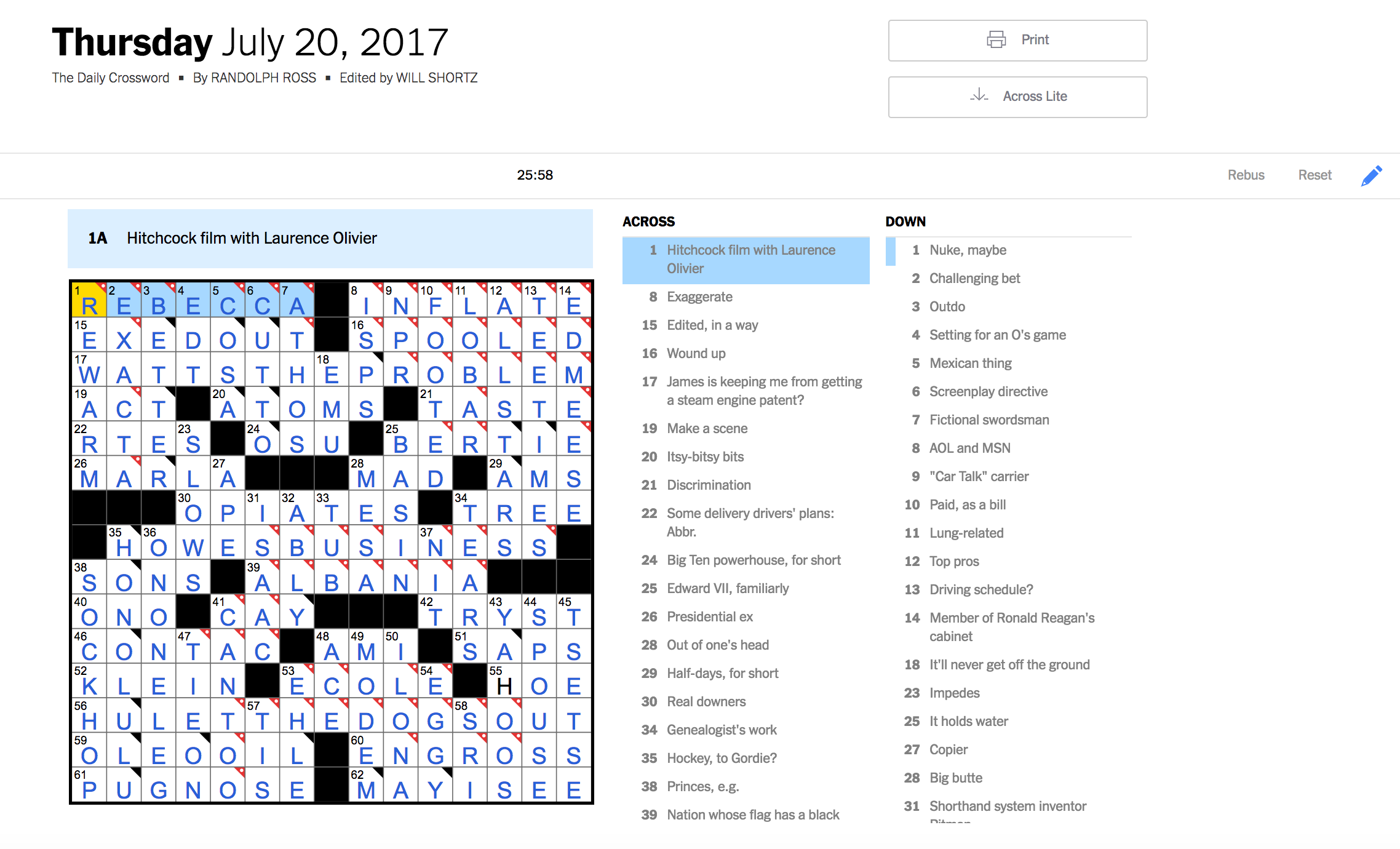
I basically had to reveal half of the puzzle, as shown in red, which isn?t a good sign.
This miserable performance was surprising: This Thursday puzzle (the first Thursday puzzle I?ve tried this month) felt an order of magnitude more challenging than the Friday and Saturday puzzles I?ve been working on (even though Thursday puzzles are theoretically supposed to be easier).
As a means of comparison, when I got home from work today, I decided to try to complete tomorrow?s Friday puzzle (NYT crosswords are published online the evening before they are in the paper).
Weirdly, without any aid, I nearly finished the Friday puzzle. Here?s what the puzzle looked like after I checked for the first time?
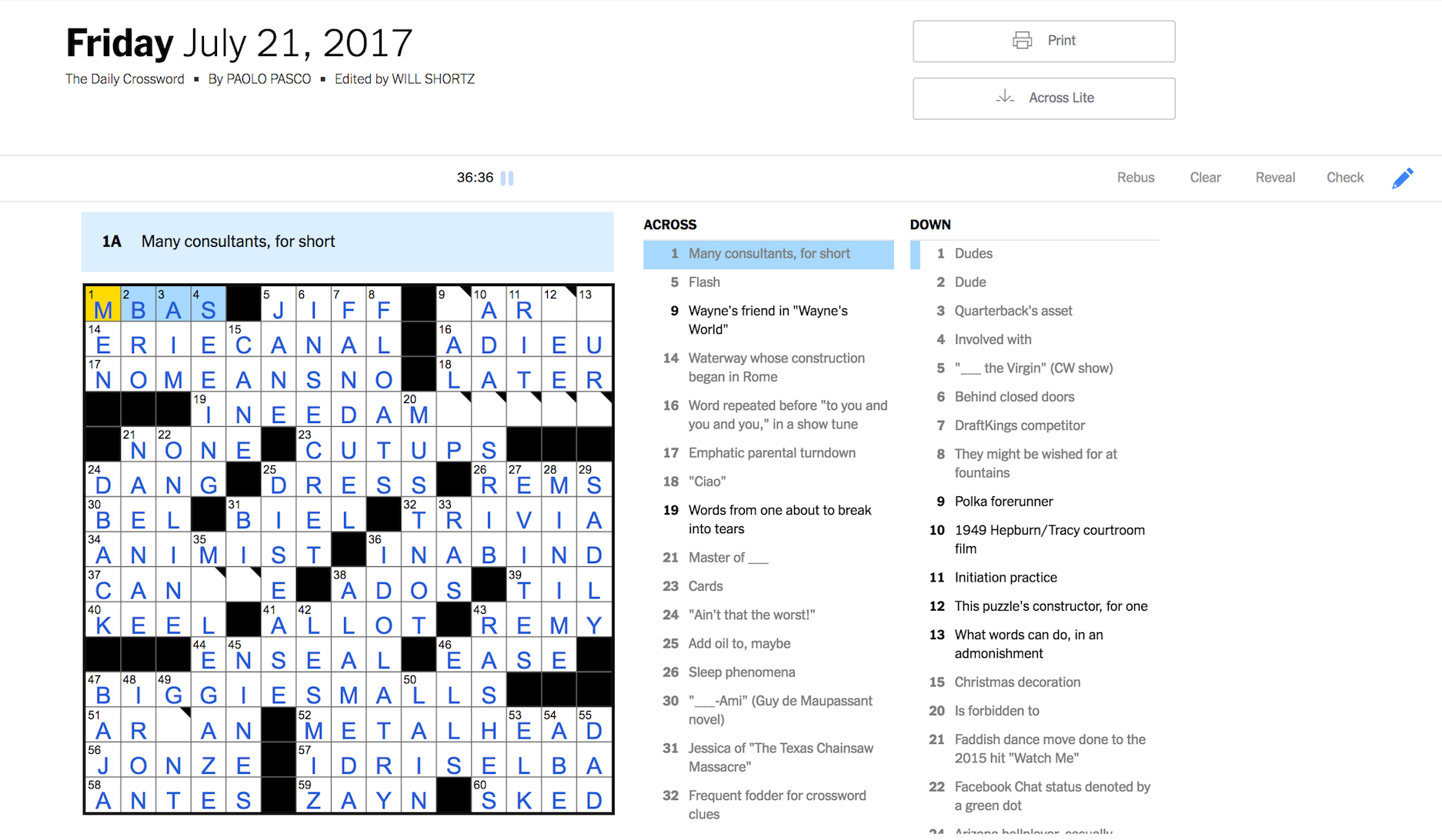
So, while I can almost finish a Friday puzzle, I can barely make a dent in a Thursday puzzle. What?s going on here?
After inspecting and reading about other Thursday puzzles, I have an idea: Thursday puzzles are easier for a well-rounded puzzle solver, but for someone who has narrowly trained just for Saturdays, I?m not actually equipped to solve a Thursday.
I found out that Monday, Tuesday, and Wednesday puzzles are more or less straightforward. As a result, just as a byproduct of my Saturday training, I can use my expanded mental crossword dictionary to solve these puzzles without a problem.
Friday and Saturday puzzles are stylistically the same, with slight differences in the number of extra-difficult clues. So, I?m also well-trained to take on Friday puzzles.
Thursdays puzzles, however, are special. They have there own style of cluing, which is noticeably different from the clueing on Fridays and Saturdays (as well as the Monday-Wednesdays).
Since I haven?t trained for Thursday puzzles at all, I?m completely incapable of casually cracking these new types of clues. I?m nearly competent at the most challenging Friday and Saturday puzzles, and yet fully incompetent at Thursday puzzles.
This is likely an unusual quirk, since most crossword solvers probably practice the puzzles in their intended sequence.
Interestingly, the same kind of quirk shows up in other areas of my life as well. For example, by the end of February (the month of my backflip challenge), I was able to land a standing backflip, but still couldn?t successfully execute a half-decent backwards roll.
These quirks arise from my tendency to train directly for my desired goal, not concerning myself with the supposed intermediate steps (when they aren?t relevant).
While this may seem like I?m building my skills on a shaky foundation, I?d tend to disagree.
For the most part, the ?traditional? progression for learning a particular skill is just an arbitrarily made-up progression and often includes steps that aren?t essential to learning the desired skill.
For example, in language learning, most people think that they need to complete years of classroom studies, grammar exercises, online courses, etc. before they can start communicating with native speakers (because this is how everyone else seems to do it). But, in fact, this progression most likely isn?t ideal ? Instead, if the goal is to speak the language, then the best path forward is to jump right to that step.
Of course, it?s hard to follow a self-guided path (and not the normal process): If you create your own progression and don?t succeed in the way you hope, it?s easy to blame yourself. However, if you follow the ?normal? progression and don?t success, it?s easy to blame the process.
Blaming the process often makes us feel better than blaming ourselves, so most people opt for this option.
For me, I like the more ?optimized?, personal approach, even if it means I need to occasionally squash my confidence. Usually, as consolation for temporarily squashed confidence, the outcome is better and the process is ultimately more rewarding.
In any case, after this month is finished, I?d like to circle back and figure out how to solve Thursday puzzles.
However, until then, I will continue to strive to crack a Saturday puzzle this month, even if it means temporarily sacrificing my Thursday-solving abilities.

A few days ago, I started adding non-Saturday crosswords (i.e. ?easier puzzles?) into my training routine. The goal, according to my three-part training framework, is to use these easier puzzles to develop a more mature strategy for the end of a puzzle, which I can then apply to my Saturday crosswords as I (hopefully) start getting to that point.
Today, to continue training for these end of puzzle situations, I focused on solving a couple of Friday puzzles (which are close enough to Saturdays for the insights to be relevant, but easy enough where I can actually generate the necessary ?end-game? insights).
Here?s one of the Friday puzzles that I completed today?
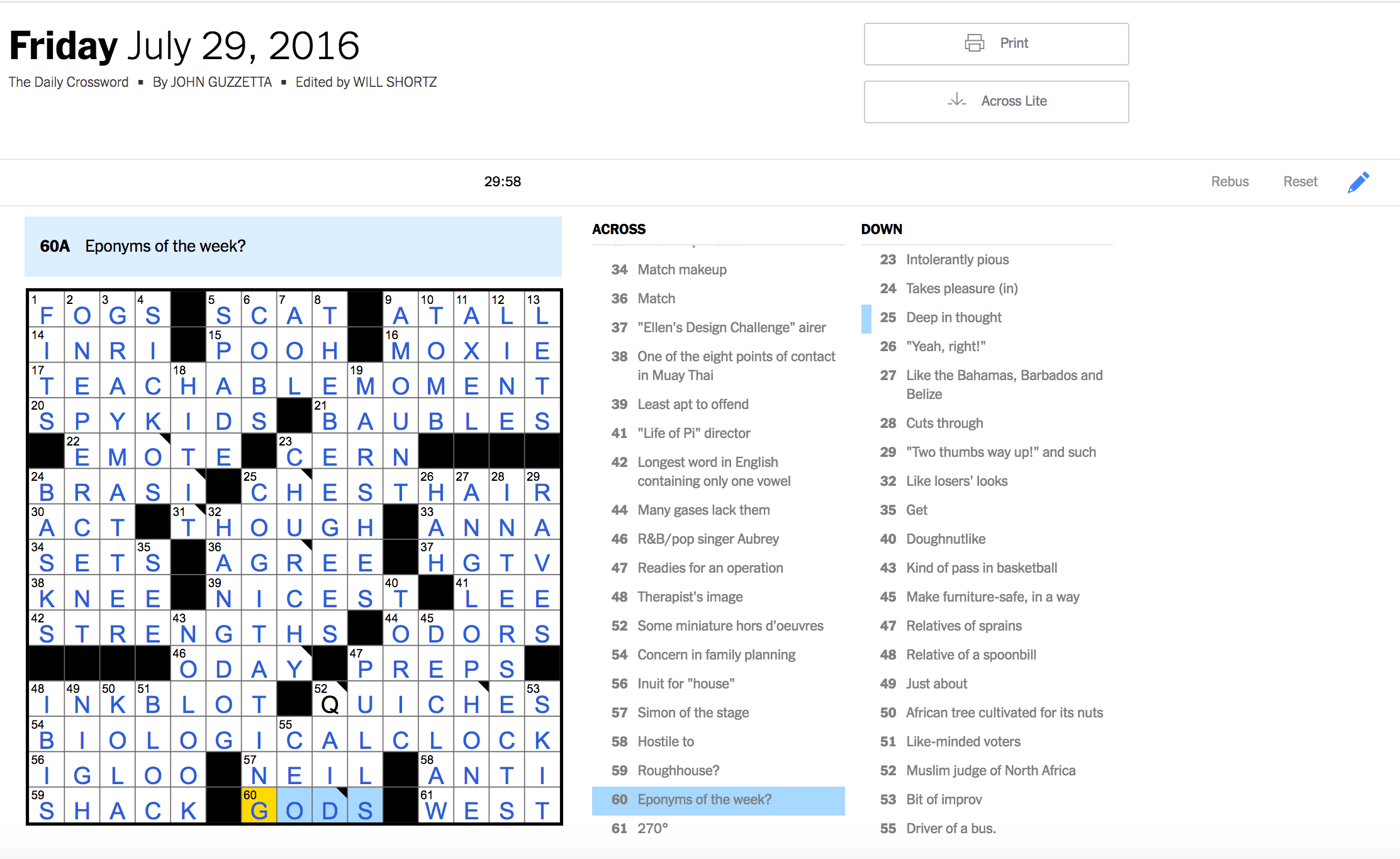
You?ll notice that I botched eight of the squares on my first try, as denoted by the black triangles.
Retrospectively, there?s no reason that I should have incorrectly filled in these squares: When I clicked the check button, to confirm my answers, I knew there were a handful of words in the puzzle that I didn?t recognize.
Sure enough, these exact ?words? just happened to contain the error-filled squares.
Upon fixing these squares, all the previously unidentifiable words magically became pretty standard words (i.e. emote, sickos, churchy, gods, quiches,agree).
I don?t remember what nonsense words I had in place of these normal-looking words, but they were certainly nonsense.
I had convinced myself that ?A Saturday puzzle is a hard puzzle. Therefore, it?s going to contain hard words. Some of these hard words I just won?t recognize?.
But this is actually rarely the case: The NYT increases puzzle difficulty almost entirely with its cluing difficulty, and not with the obscurity of its answers.
So, if I see a word that I don?t recognize, it probably contains an error.
This insight now seems obvious, but, before explicitly recognizing it, I continued to make this same kind of error (i.e. submitting unrecognizable words) over and over again.
Anyway, my end-of-puzzle approach is starting to come into focus: Once I?ve filled in the entire puzzle, I should read through and find any word that I don?t recognize. Then, I should assume this answer is incorrect, and try to figure out how to make the answer into a real word by changing one or two of the squares (before ever looking at the clue). Finally, once I?ve determine the most reasonably likely real-word answer, I should check the clue and see if I can use it to justify the answer . If so, great. If not, it?s still likely correct.

I made a bit of a mistake?
This morning, I woke up excited to take on today?s Saturday puzzle on video.
To ensure the best possible solve, I decided to warm up with a Friday puzzle from 2016. In 17 minutes, I finished the Friday (with one mistake), which is probably my best performance all month.
Surprised, I decided to see how crossword blogger Rex Parker rated the puzzle?s difficulty. And this is where the mistake happened?
Out of habit, I typed ?rex? into my browser, rexwordpuzzle.blogspot.com autofilled, and I clicked enter.
As soon as the page loaded, I realized my mistake, but it was too late: The answers to today?s Saturday puzzle were rendered right in front of me.
I quickly looked away, but my brain had already registered some of the answers.
As a result, I couldn?t fairly solve today?s puzzle on video, which is particularly frustrating given that the puzzle is apparently ?suuuuper-easy?.

Nevertheless, I had to opt for Plan B: The 2017 Saturday puzzles.
So far this month, I haven?t solved a single 2017 Saturday puzzle, saving them for this last week of this month?s challenge.
Today, I decided to start at the beginning with the January 14 puzzle. (The first Saturday of the year is from January 7, but I had previously started that puzzle, so the 1/14 was the first completely clean crossword).
In 28 minutes, I completed the entire puzzle perfectly with the exception of two squares. Upon entering in the last letter, I actually thought there was a 50% chance that the entire puzzle was correct (thereby officially completing this month?s challenge). I was wrong, but still ? I surprised myself once again with this week?s performance.
Something about being on camera pushes me to perform at my highest level, so I plan to film all puzzles moving forward.
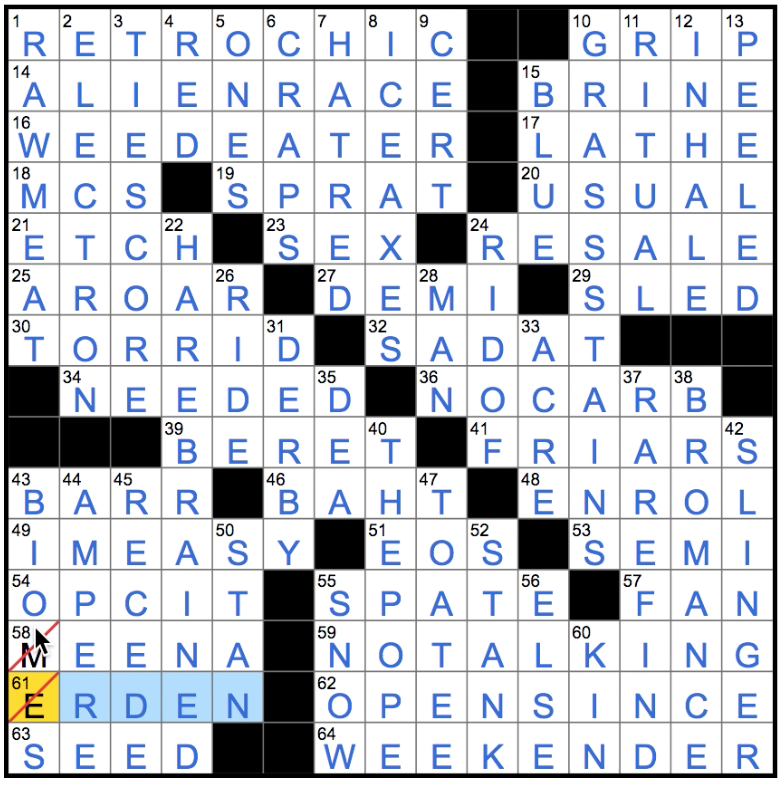
Here?s the timelapse of today?s solve?
And here?s the full video, if you?re interested in watching me um and hmm my way through the puzzle?
To be fair, Rex Parker does exclaim that this particular puzzle ?was phenomenally easy?, so I?m not sure if I can replicate this performance on any given Saturday puzzle. But, since my goal is only to complete one Saturday NYT crossword, I welcome these kinds of outliers.
Anyway, I will continue training a little bit over the next week, but it seems like I?m at the point where I just need to run through the remaining 2017 puzzles and see if I can perfectly crack one of them. From a skill standpoint, I?m apparently ready for the final sprint.
(I may also return to today?s July 22 puzzle in a few days, most likely for training purposes, assuming my brain can forget what it has seen).

Yesterday, I completed the 1/14/17 Saturday NYT puzzle with only two mistakes, so I knew it wouldn?t be long before I perfectly cracked one of the 2017 puzzles.
Today, I continued on to the next Saturday of 2017, with the January 21 puzzle.
After 21 minutes and 35 seconds, I filled in the last square, and for the first time ever on a Saturday puzzle, I was shown this message?
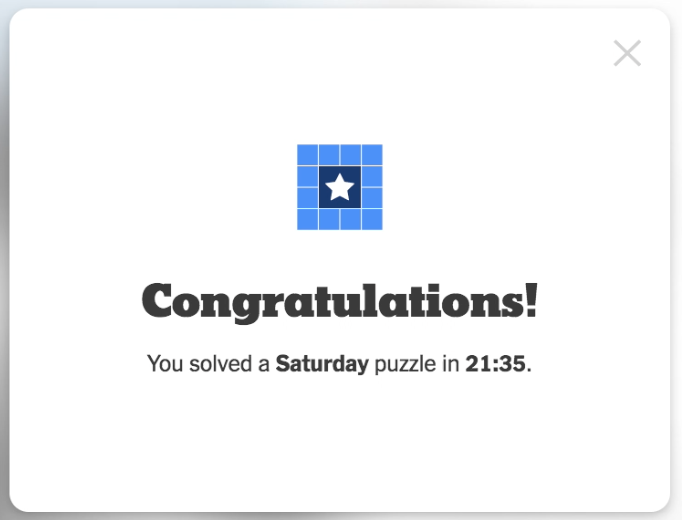
In other words, I perfectly solved the puzzle, officially completing this month?s challenge, which I?m quite excited about.
(The last letter of the puzzle was a guess, so I was particular happy when I saw the ?Congratulations? message. It could have gone either way.)
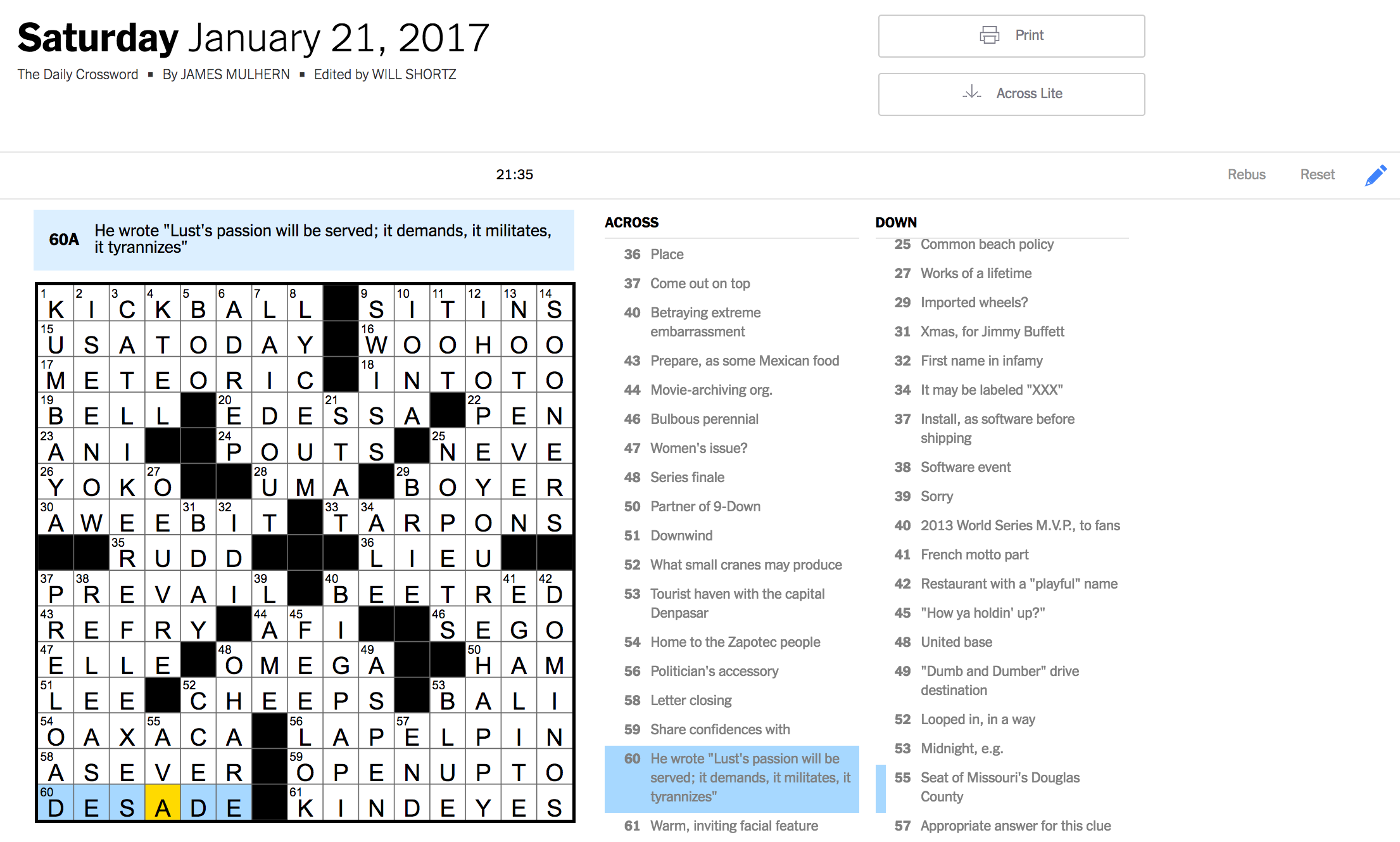
Here?s the timelapse of my solve?
And here?s the full video with commentary?

Yesterday, I successfully solved a Saturday NYT crossword puzzle, officially completing this month?s challenge.
I had expected to grind this challenge out until the very last day, so I was certainly surprised at how quickly things came together in the past few days.
While I?m excited about the victory, its early arrival disrupted this month?s narrative arc a bit. I still have much I want to say about my training methods and insights ? especially because half of this month?s goal was to discover and codify a reproducible training approach ? so, I can use this remaining week to do just that.
Today, I took a break from crosswords, which was a bit of a jolting change: For the past three weeks, I?ve been cramming 2?3 hours of puzzles into 20-minute increments throughout my day, so I forgot what it was like to have all that free time.
In place of crosswords, I was able to crank through the audiobook rendition of The Big Short today (I?d recommend it. This was my second listen, and it was still just as good). I?ve had less time this month for ?reading?, so I was happy to enjoy a good, entertaining story (especially when it?s Michael Lewis).
Anyway, tomorrow I?ll return to the regularly scheduled program, and discuss my approach for mastering crossword puzzles.

In retrospect, the Crossword Trainer (the computer program I wrote to memorize the 6,000 most popular crossword clues and answers) was hugely important to my success this month.
However, I didn?t always think so.
On July 9th, I analyzed the Saturday July 8 NYT crossword, revealing that only four of the answers in the puzzle exactly matched clue-answer pairs in my training dataset. If I assumed that clues didn?t matter, then 45% of the grid would be filled with answers from my dataset, but this felt like a faulty assumption (and so, I determined that I couldn?t count these answers as automatic).
In other words, even if I spent 30+ hours memorizing the entire dataset, I would barely get any measurable help on actual puzzles.
Therefore, at this point, I mentally decided that the Crossword Trainer was a waste of time, and I stopped using it.
Yet, after a few days without the Crossword Trainer, my progress flatlined (or perhaps even regressed). So, I realized the there was something beneficial about the Crossword Trainer ? I just didn?t know what.
Now, with two additional weeks of experience with the Crossword Trainer, I realize that I came to the wrong conclusion originally: It didn?t matter if I remembered the particular clue for a given answer. Instead, it was just important that I had exposure to the answers and exposure to the clues ? but not necessarily as ?pairs?.
I?ll explain this idea further tomorrow, but for now, I want to lay out the empirical evidence:
Here?s the Saturday puzzle that I successfully solved a few days ago?
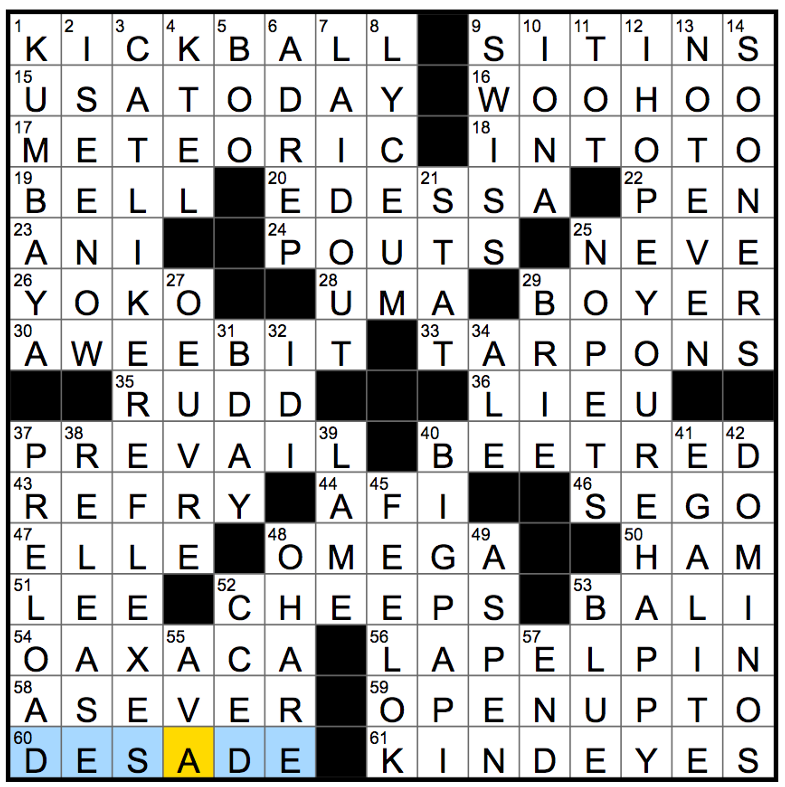
Here?s the same puzzle, but I?ve highlighted all the words that I memorized as part of my training with the Crossword Trainer. I?ve also included ?As Ever? and ?In Toto? because these are answers I remember seeing from other crosswords (even though they weren?t in my dataset).

Two weeks ago, my original assumption was that most of these words wouldn?t be automatic (since I memorized most of these answers in the context of very different clues). In other words, it wouldn?t materially help me to memorize them.
However, if you watch the video of my solve, you?ll see that, with the exception of DESADE and AFI, all these other answers came to me almost instantly.
Empirically then, my original analysis seems wrong: By memorizing just these answers, I was able to mostly get these words for free, giving me enough momentum in each section of the grid to fully complete the puzzle.
Tomorrow, I?ll try to explain the theory and my explanation for this empirical observation.

Here?s a doodle. What does it look like to you?
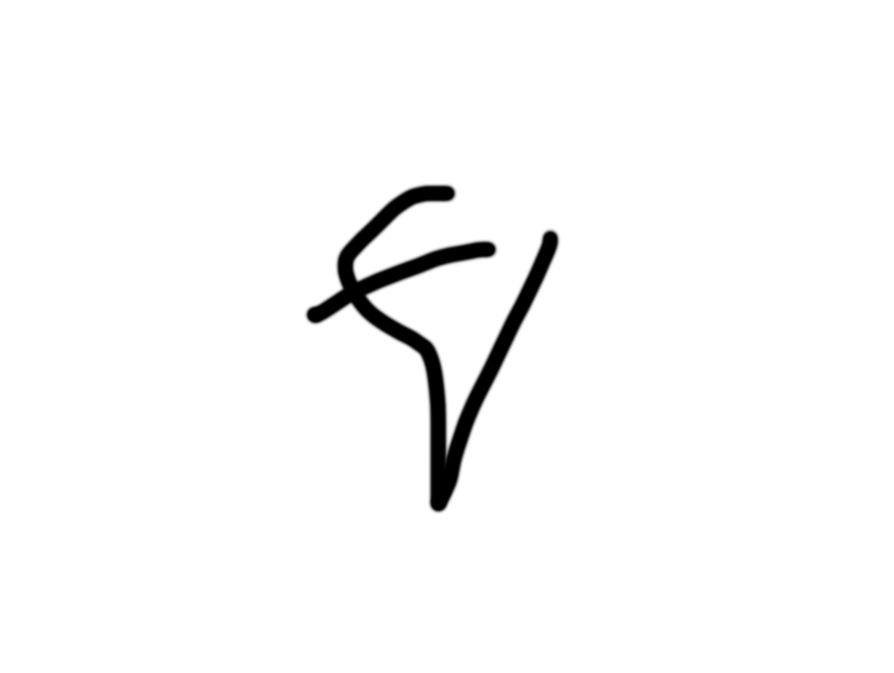
How about now?
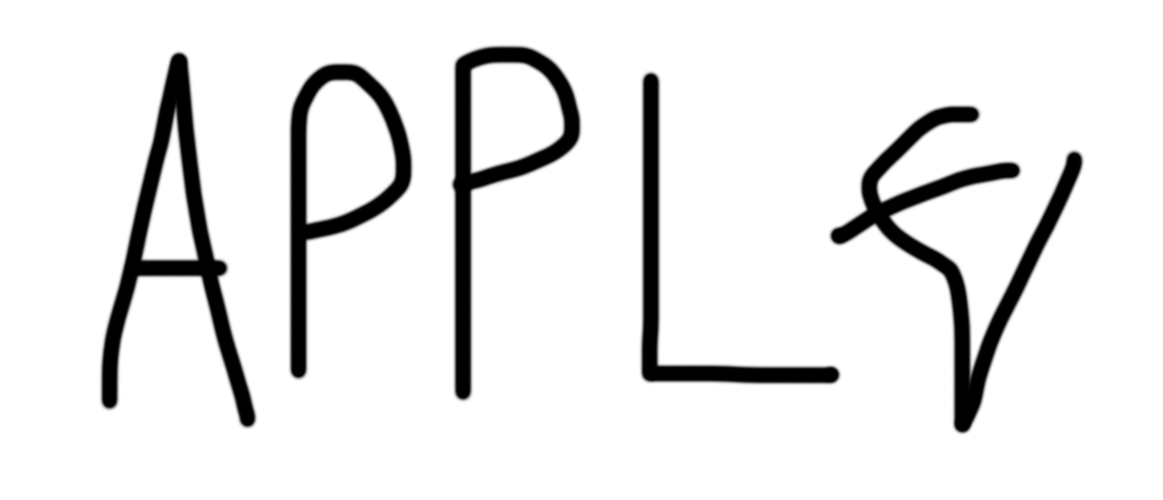
In the context of the word, it?s much more easily recognized as the letter E, and yet, it?s the same exact squiggle.
This is because your brain tries to predict the future, which affects the way you see the world. In other words, your interpretation of the world isn?t objective ? instead, your brain is primed in some way or another, skewing your interpretation of the world to more closely match your priming.
This is why Republicans and Democrats are more likely to think that their respective candidate won a presidential debate, for example.
This is also why, after you see the letters ?APPL?, your brain drastically lowers its standards on what it?s willing to except as an E. Your brain anticipates an E, because of its priming, letting it more easily interpret the input as such.
If you?re interested in the science, I?d recommend that you check out the books On Intelligence and How to Create a Mind, or this TED talk:
But, in short, to continue with the ?APPLE? example, your brain has some pattern recognizer that is devoted to recognizing the letter E. When it sees the squiggly E from above, this visual input is passed through your E pattern recognizer. Based on how much the pattern recognizer thinks the input is actually an E, it will output some amount of electrical activity. If this activity surpasses a certain threshold, a message is sent to your brain, letting it know that it has seen an E. If the threshold is not reached, your brain says ?Nope, not an E?.
When you see the squiggle without any context, your brain?s E pattern recognizer has a pretty high threshold. After all, there?s no reason for it to expect an E. In fact, there?s no reason that it should even expect to see a letter from the alphabet.
However, once your brain is primed with APPL, the threshold of the E pattern recognizer is significantly dropped, preparing itself to call just about anything an E.
Your E pattern recognizer may even be willing to accept something like this?
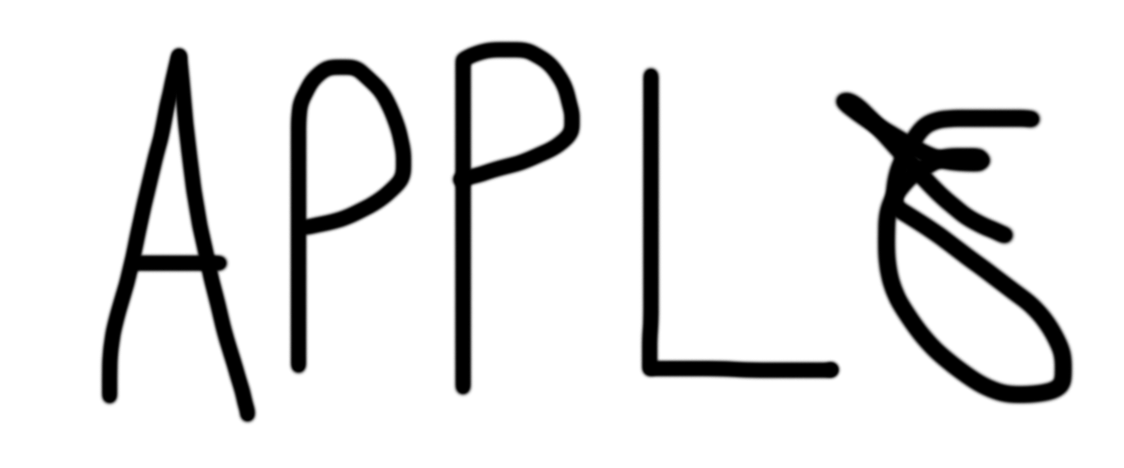
Certainly, you see the word Apple.
Anyway, the point is that our brains work in two directions at all times: One direction is from sensory inputs to interpretation. The other direction is from prediction (interpretation of the past) to sensory inputs, affecting how real-time data is consumed.
So, what does this have to do with crossword puzzles?
In the beginning of the month, I assumed that my brain only solved crossword puzzles in one direction: From clue to answer.
In other words, I highly valued my ability to parse a clue in isolation. This is why I incorrectly declared that my ?Crossword Trainer? was useless, since it was unlikely that I would see an exact clue-answer pair from a previous crossword in a new puzzle.
But, in reality, solving a crossword is all about thinking and anticipating in both directions (from clue to answer, and from answer to clue).
For example, in this past week, as I read a clue, I found myself trying to anticipate the answer before I ever looked at the grid, priming my brain accordingly. Then, I would look at the grid, and because I had this priming, I was able to more strongly validate or invalidate my guess.
Additionally, when I saw a partially-completed answer, I would anticipate what the full answer and corresponding clue would be. Then, I would validate this guess against the actual clue.
By creating this loop of anticipation, my brain became much more receptive to finding the right answers in the crossword puzzle.
This is why, in many cases, during my successful solve, the correct answers often came to me instantly, even though the clues could likely correspond to many potential answers.
In this way, when I was using the Crossword Trainer to memorize the 6,000 most common crossword answers, I was essentially priming my brain to anticipate the most likely words within any given crossword. This helped me build up the necessary mental anticipation in the direction of clue to answer.
Then, I used my Letter Trainer, to practice using partial answers to anticipate clues (i.e. in the direction of answer to clue).
With both of these anticipation capabilities, I was able to create a highly effective mental feedback loop.
The power of this feedback loop seemed to grow exponential as I added more and more underlying data, which is why I made huge jumps in ability in the past week and why I was caught by surprised (I projected that my abilities would grow more or less linearly).
Anyway, the point is? My Crossword Trainer and Letter Trainer were able to harness this feedback loop and become much more effective training tools than I originally suspected.

In a few hours, I?ll be heading to the airport and hopping on a flight to Los Angeles. I?m a visiting a friend for the weekend, and then flying back to San Francisco on Sunday night.
I had planned this trip three months ago, with little regard for its implications on the M2M project, which was a bit risky: If I hadn?t finished this month?s challenge up until this point, these four days would be particularly valuable.
Nevertheless, I successfully completed a Saturday NYT puzzle last weekend, giving me plenty of time to enjoy this mini-vacation in LA.
I actually think that my early success can almost be fully attributed to this trip: In my mind, I operated as if I only had from July 1 until July 26 to complete this month?s challenge, and as a result, I boosted the intensity of each day?s training accordingly (in order to properly amortize the necessary practice across the allotted days).
This is a classic example of Parkinson?s Law, which states that ?work expands so as to fill the time available for its completion?.
In fact, the entire M2M project is an exercise in Parkinson?s Law: By strictly limiting myself to one month of practice, I?m forcing myself to fit the necessary work in this accelerated timeframe.
Ultimately, with this project in general, I hope to demonstrate that we don?t need unlimited time to achieve our goals. Instead, if we seriously commit to our goals during the time that we do have, we can figure out ways to make substantial progress without disrupting the rest of our lives (whether that means working a full-time job, traveling, meeting up with friends, commuting, exercising, etc.).
Anyway, I?m excited to head to LA. It?s my first time there in over 10 years.

At the beginning of this month, I remarked that ?crossword puzzles can theoretically contain clues and answers from an infinite knowledge base?.
In other words, I was assuming that the contents of any given crossword puzzle are barely correlated to the contents of any other crossword puzzle. I reasoned that every puzzle would contain its own nearly unique set of trivia pulled from some infinite pool of crossword-eligible knowledge.
But, this is quite far from the case. Instead, it seems that there is some kind of physics that governs what can and cannot find its way into a crossword puzzle, resulting in grids with contents that are heavily correlated.
Essentially, creating a clean 15×15 grid of interlocking words requires some reliance on certain patterns of the English language, which forces crossword constructors to lean much more heavily on words better suited to fit into these kinds of grids.
As a result, the same types of words show up over and over again in crossword puzzles, creating patterns that are surprisingly more learnable than I anticipated.
I also suspect that, as crossword constructors uncover these grid-friendly words, they start relying more and more heavily upon them, perpetuating these patterns even further.
Thus, it seems that crossword puzzles are much more finite in scope that I originally thought, which is largely why I was able to improve my solving abilities so quickly. I didn?t actually need to memorize a massive corpus of trivia ? instead, I just needed to get an intuitive feel for the common patterns (as dictated by the constraints of the English language).
This Physics of Crossword Puzzles was an idea I?ve been thinking about for the past few days (I had planned to write this particular post earlier this week). So, I was particular surprised when this exact idea was presented to me in an unexpected place?
Yesterday, during my flight to LA, I listened to the audiobook A Mind at Play, which is about mathematician Claude Shannon, the inventor of ?Information Theory?.
Information Theory is the mathematics of encoding, storing, and communicating information, which is highly relevant to crossword puzzles. However, I didn?t make this connection when I started the book yesterday morning.
While I was waiting in line at airport security, listening to a part of the book about information redundancy (about 50% of the way through), I finally realized the parallels. I thought: ?Wow, this is so related to crosswords. This will be a perfect way to start tomorrow?s Medium post?.
A minute later, the book takes an even more explicit turn?
In his theory of communication, Shannon guessed that the world?s wealth of English text could be cut in half with no loss of information: ?When we write English, half of what we write is determined by the structure of the language and half is chosen freely.? Later on, his estimate of redundancy rose as high as 80 percent: only one in five characters actually bear information.
As it is, Shannon suggested, we?re lucky that our redundancy isn?t any higher. If it were, there wouldn?t be any crossword puzzles. At zero redundancy, in a world in which RXKHRJFFJUJ is a word, ?any sequence of letters is a reasonable text in the language and any two dimensional array of letters forms a crossword puzzle.? At high redundancies, fewer sequences are possible, and the number of potential intersections shrinks: if English were much more redundant, it would be nearly impossible to make puzzles. On the other hand, if English were a bit less redundant, Shannon speculated, we?d be filling in crossword puzzles in three dimensions.
In other words, according to Shannon, because of the strict structure of the English language, we are just barely able to successfully construct reasonable crossword puzzles. As a result, this strict structure andredundancy come across very strongly within puzzles, creating the patterns I was able to tap into.
If you?re interested in learning more about ?Information Theory?, or the about the idiosyncratic life of Claude Shannon, I?d highly recommend the book.

One of the main features of my training this month was ?memorizing? the 6,000 most common crossword clues and answers.
In a similar fashion, during my Rubik?s Cube month, I memorized a few dozen speed cubing algorithms, and during my foreign language month, I memorized a handful of Hebrew words. And, of course, during my memory month, I memorized three different mnemonic images for each of the 52 playing cards.
In the context of mastering all of these skills, memorization played an important and necessary role. But, I?m worried that this may overemphasize ?memorization? as a key part of the self-education process.
In most cases, the ability to memorize information doesn?t distinguish one learner from another. Instead, learners are distinguished by their ability to know what they should and should not memorize.
In other words, the art of learning isn?t about the assimilation of information, but about identifying which information is even worth assimilating.
We traditionally think about memorization in the context of a 7th grade student memorizing a stack of flash cards in order to reproduce this information on a test. In this scenario, the student doesn?t need to determine what?s important and what?s not ? the teacher does this on the student?s behalf ? effectively depriving the student of the valuable part of the learning process.
In this way, we?ve been trained in school to overvalue memorization as the meat of education, blinded to the ?curriculum-building? parts of the process.
So, while memorization may be the more visible, active, and tangible part of many of my learning challenges, it?s not the driving force behind my monthly learning successes.
Learning success is driven by the effective deconstruction and reconstruction of a skill. Memorization can be a tool used in this process, but it doesn?t define the effectiveness of the process.
This is important to remember, since rote memorization can feel quite productive and often simulate the feeling of effective learning. And yet, if we?re not conscious of what we?re choosing to memorize, we might not be learning as effectively as we hope.
Something to think about?
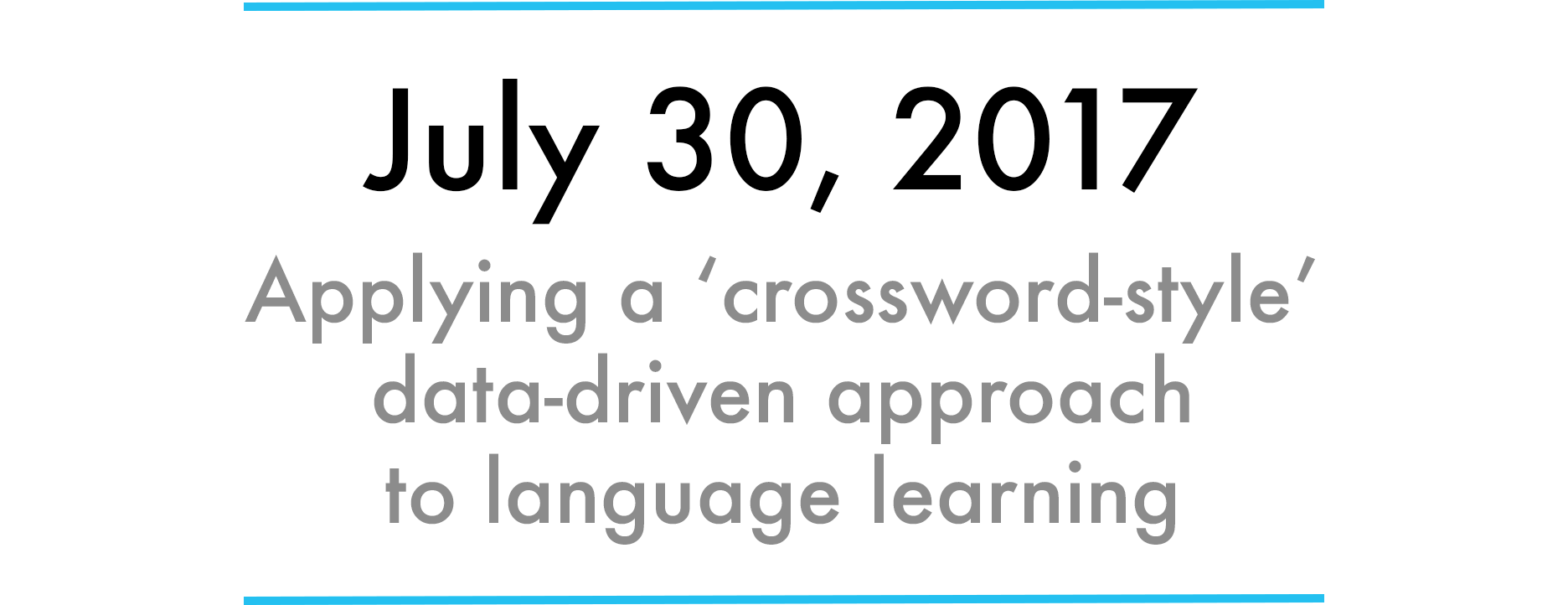
On the first day of the month, I explained that solving crossword puzzles is considered one of the few activities that doesn?t have a standard training approach. As a result, part of this month?s challenge was uncovering a standardizable approach to crossword puzzles that can be reproduced by others.
Over the past few weeks, I?ve created some interesting crossword-specific training methods (like the Crossword Trainer and the Letter Trainer), but, upon reflection, these aren?t exactly new training methods.
Instead, they borrow heavily from common language learning approaches, effectively treating the crossword lexicon as a new foreign language (as I?ve described in previous posts).
And yet, while most of this month?s techniques are borrow and repurposed, there is one technique from this month?s crossword effort that I want to explicitly contribute back to the practice of language learning: Data-driven vocabulary prioritization.
As part of my crossword training, I memorized 6,000 pairs of clues and answers from previous crossword puzzles. To select these 6,000 pairs, I aggregated all NYT crossword data from 2009?2016, and then sorted this data based on the frequency of the entries. In this way, I was able to memorize the historically most useful word first, followed by the second most useful word second, and so on.
By using this data-driven approach, I was able to quantitatively ensure that I optimally sequenced my training, prioritized by the highest impact activities.
Language learning can certainly benefit from this kind of rigorous prioritization of vocabulary, given that language learners traditionally learn new words in the order dictated by textbooks or courses, and not in the order of most importance or relevance.
Here?s one idea: To create the optimal language learning dataset, I would aggregate all the emails, text messages, and Facebook messages that I?ve sent in the past few years, reduce these conversations into their individual components (words and phrases), and then sort these words and phrases by frequency.
In doing so, I would discover exactly which words I use most often to express my ideas, letting me shape my language learning curriculum around the ways I actually communicate. (If anyone is looking to build a language learning app/company, this could be a cool idea. You are welcome to steal it).
In general, it?s important to occasionally reflect on the ways certain domain-specific methods can be applied to other domains. Most learning tasks are more similar than different, so cross-training can often inspire previously unexplored, yet highly promising approaches.

It?s the last day of July, which means it?s time to look back and see just how much time I spent on this month?s challenge.
My time was allocated across three activities: 1. The Crossword Trainer, 2. The Letter Trainer, and 3. Actual NYT puzzles.
1. The Crossword Trainer
During the month, using the Crossword Trainer, I memorized 6,000 pairs of crossword clues and answers from my dataset (of 12,707 pairs). I memorized at a rate of 400 words every 54 minutes, so I spent a total of 13.5 hours on this activity.
Additionally, I spent 1.5 hours aggregating the crossword data and building the Crossword Trainer.
2. The Letter Trainer
I mostly used the Letter Trainer as a twice-daily 15-minute warm-up activity during my last week of training. In total, I spent 3.5 hours on this activity ? plus 0.5 hours building the Letter Trainer.
3. NYT puzzles
During the month, I completed 62 NYT crossword puzzles. Most of these puzzles were Saturdays, but there were also a handful of Fridays and a few puzzles from earlier in the week.
In my practice log, I recorded the times I spent on each puzzle to the nearest minute: 14 + 14 + 30 + 8 + 30 + 36 + 33 + 50 + 54 + 27 + 26 + 26 + 42 + 24 + 40 + 44 + 26 + 13 + 17 + 22 + 18 + 19 + 20 + 18 + 19 + 21 + 20 + 20 + 14 + 20 + 20 + 17 + 18 + 25 + 21 + 32 + 30 + 24 + 28 + 25 + 18 + 18 + 17 + 24 + 24 + 28 + 29 + 56 + 21 + 30 + 38 + 26 + 30 + 55 + 63 + 27 + 21 + 7 + 18 + 31 + 22 + 26 = 27 hours.
Therefore, in total, I spent 46 hours on this month?s challenge.
This is the most time that I?ve spent on any of my M2M challenges so far. In fact, the average time for my past challenges is about 21 hours, so this is more than double my average.
I?m not surprised though ? I definitely felt like I put in twice as much work this month, which the challenge seemed to require.
Nevertheless, I believe this kind of effort is still feasible for most people: I only spent an average of 2 hours per day over 23 days (mostly spent in two one-hour blocks during my 3 hours of daily commuting).
![]()
